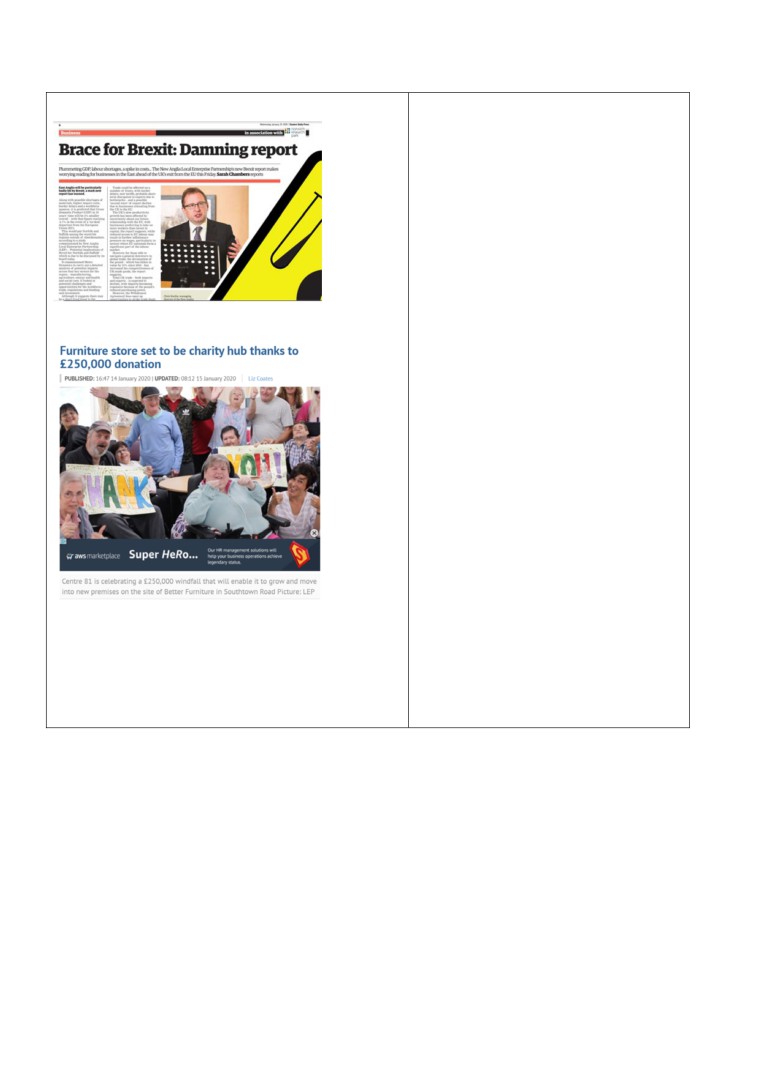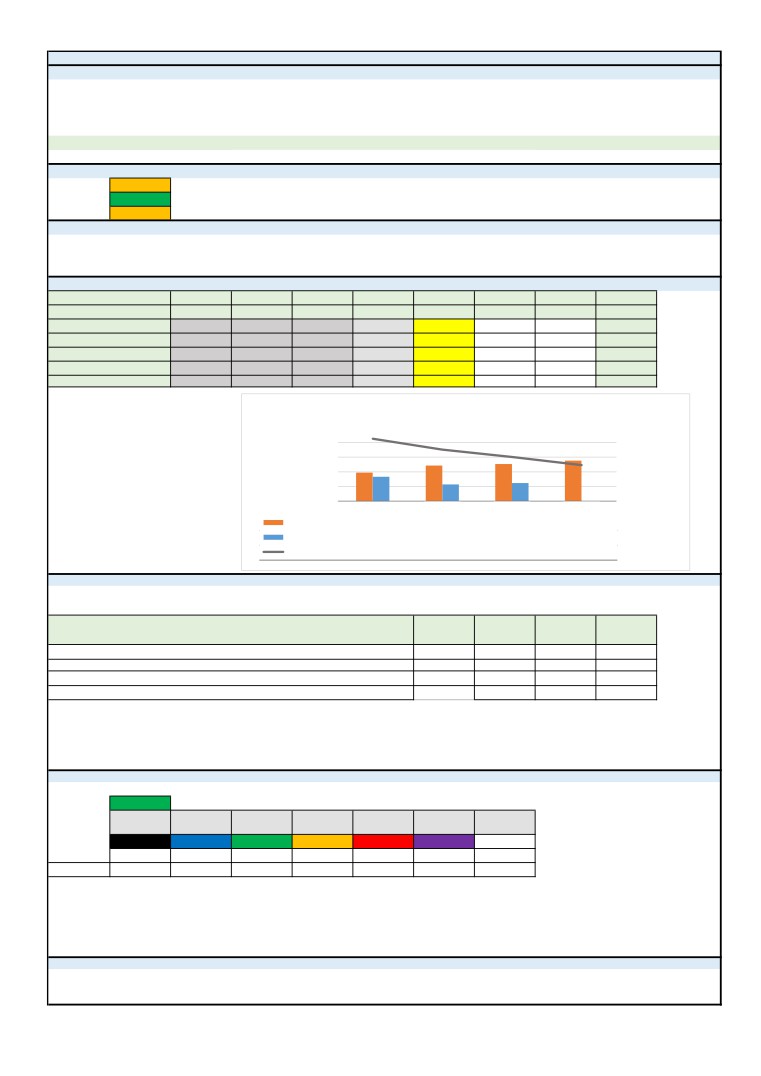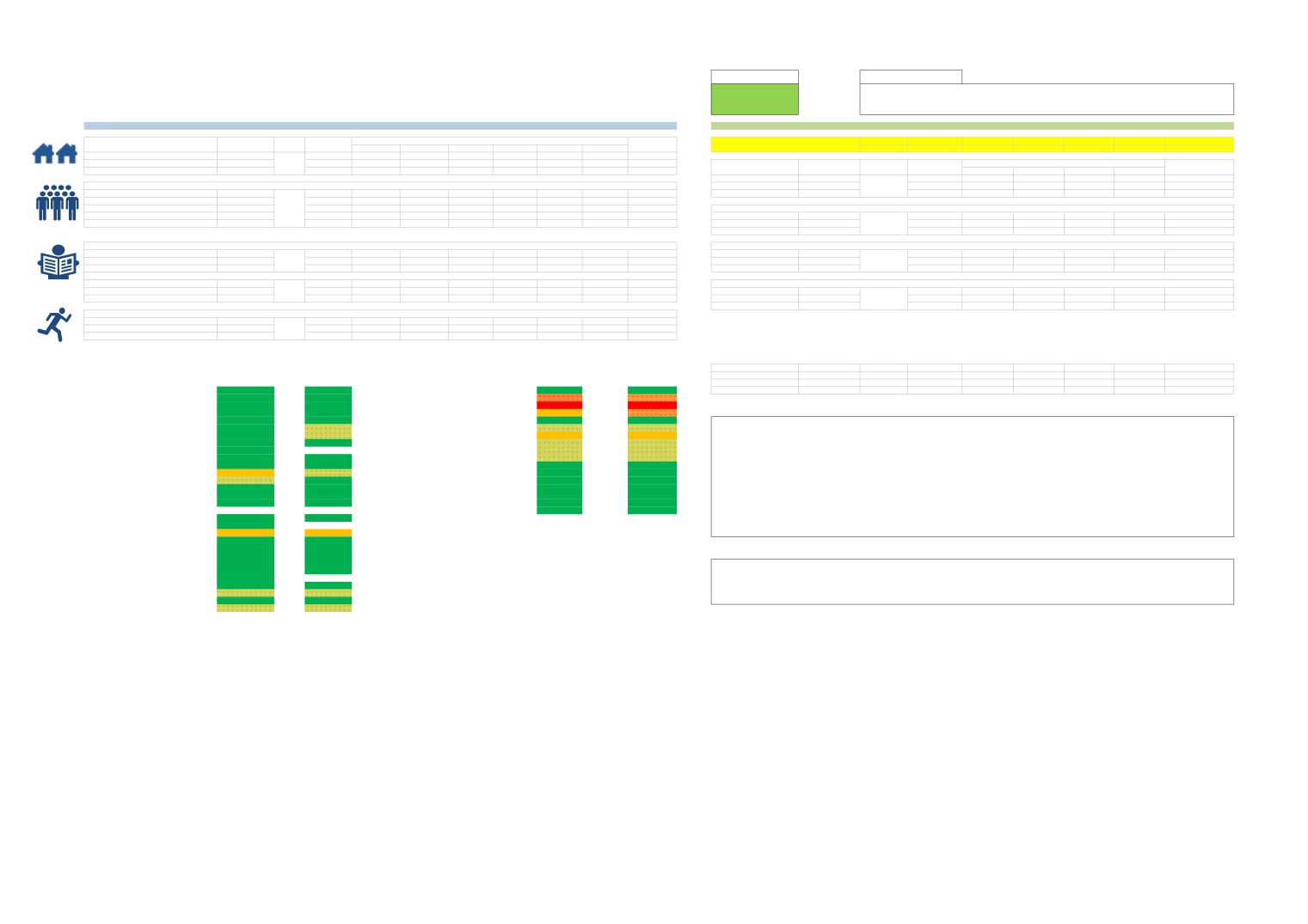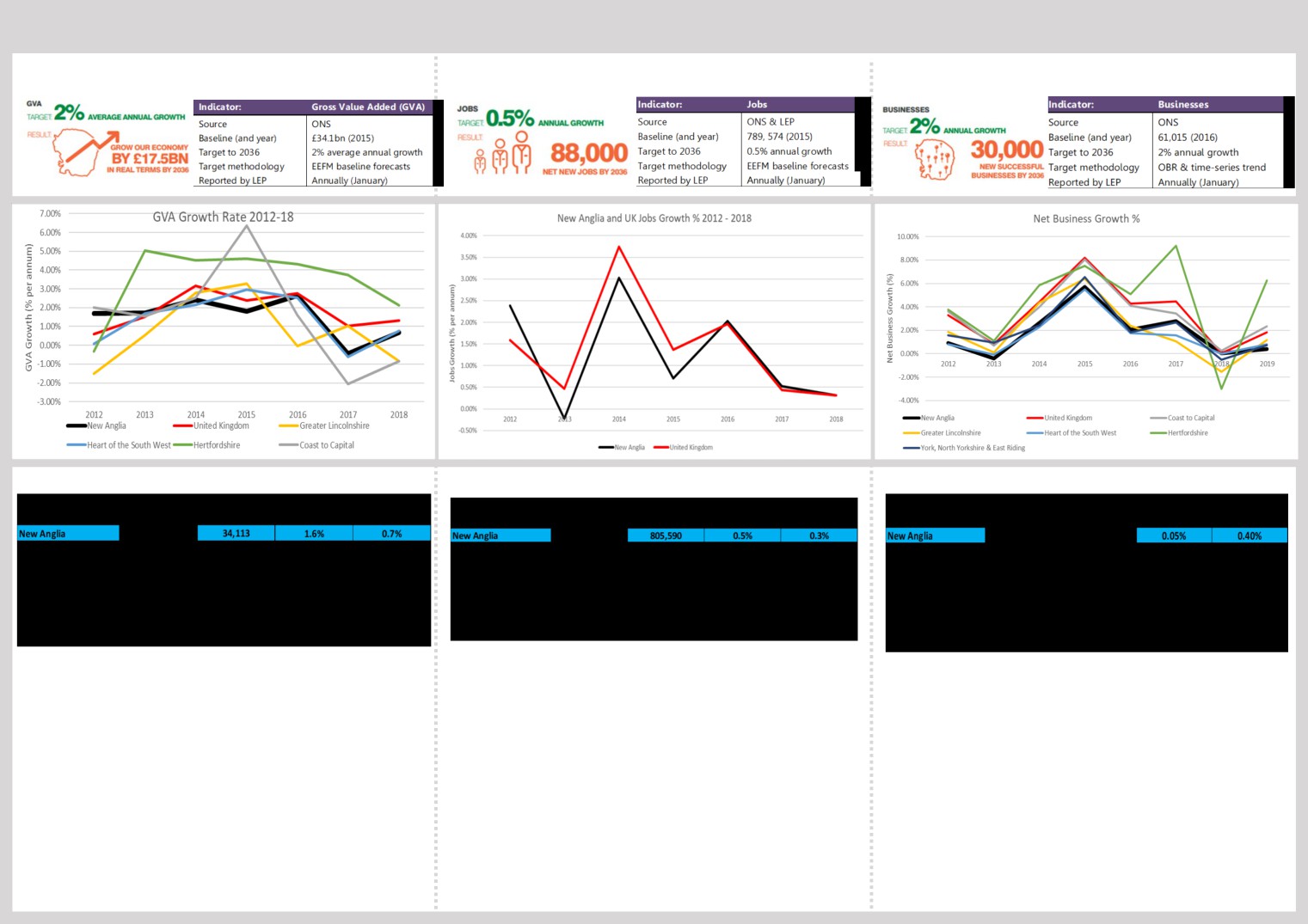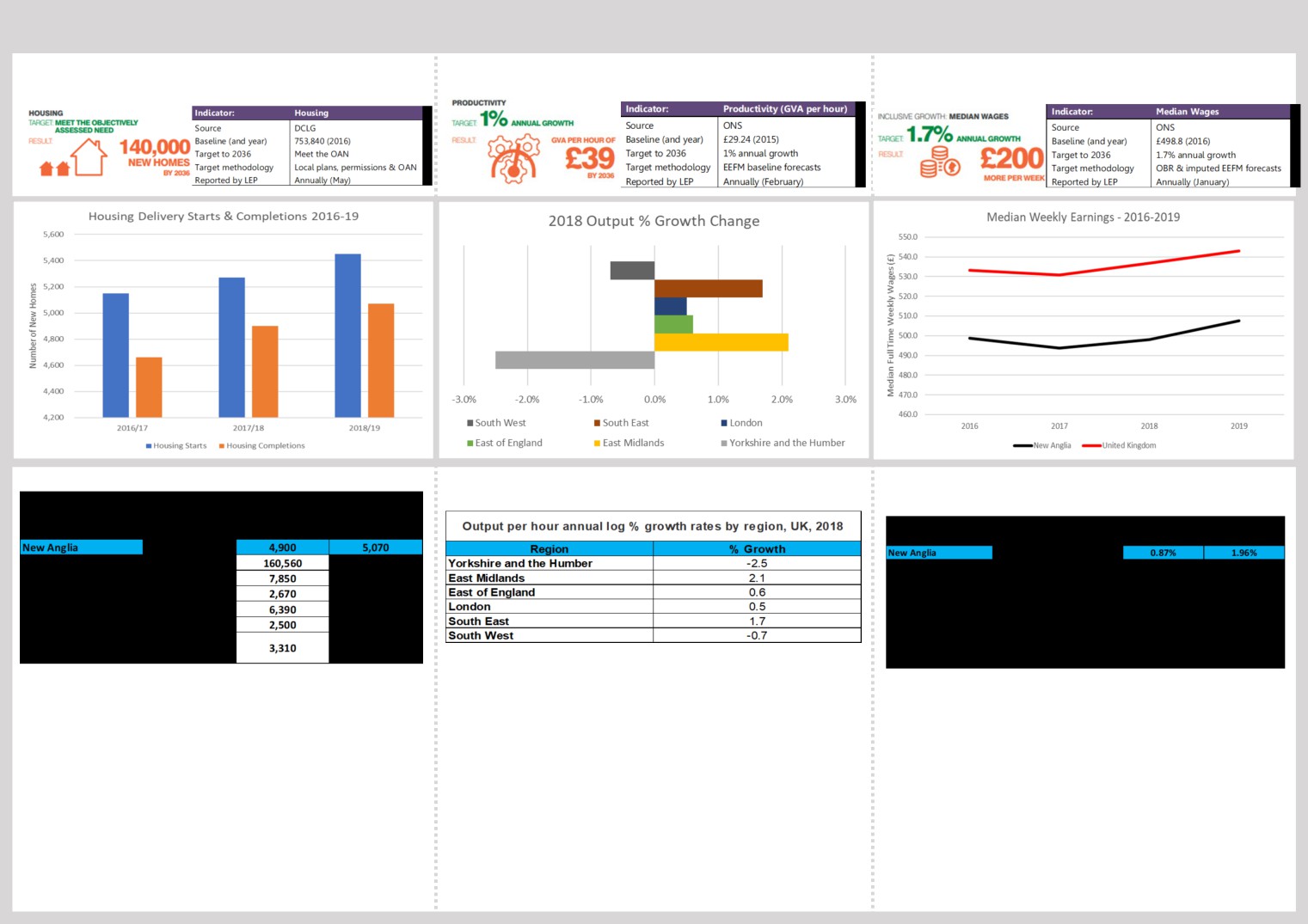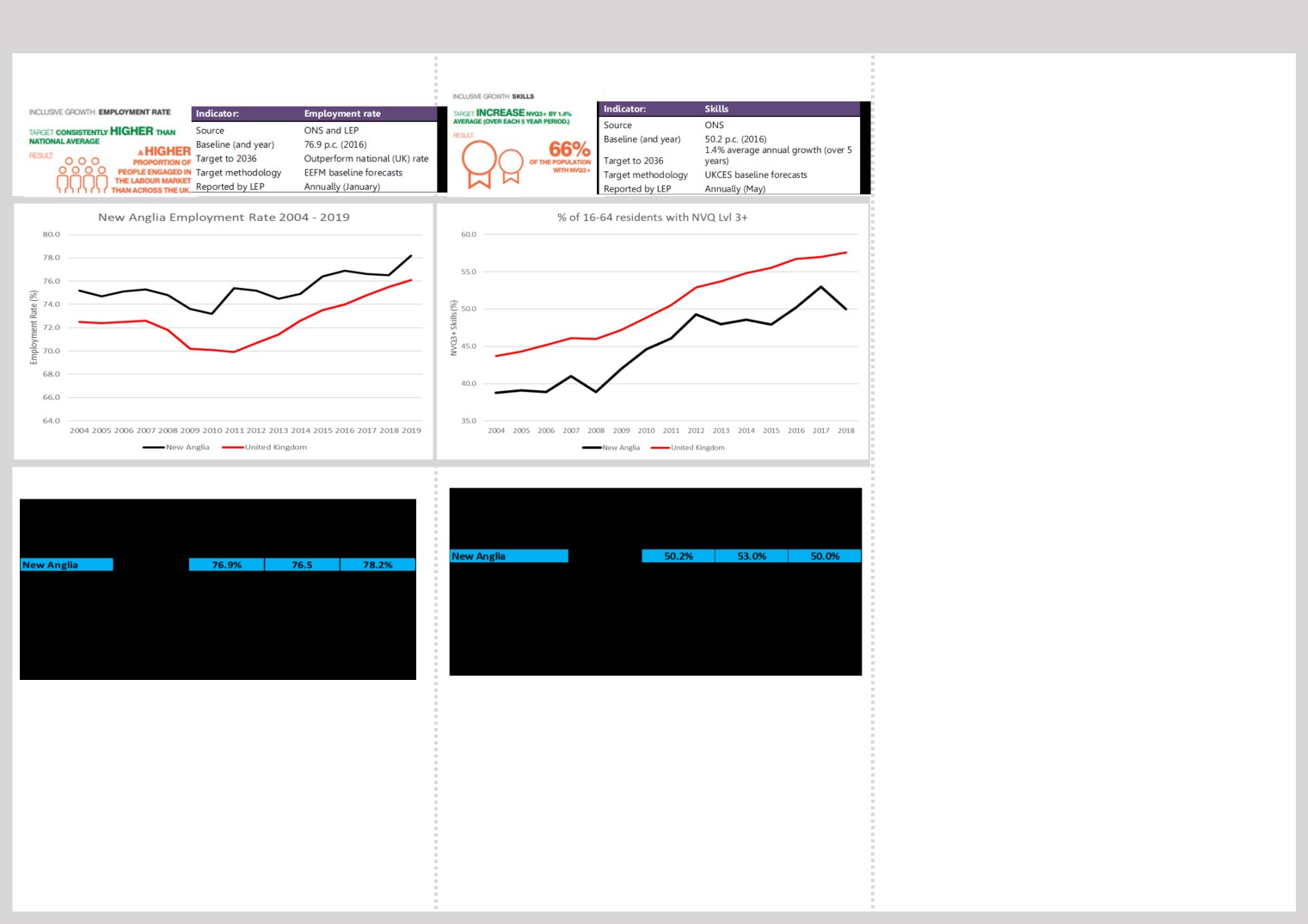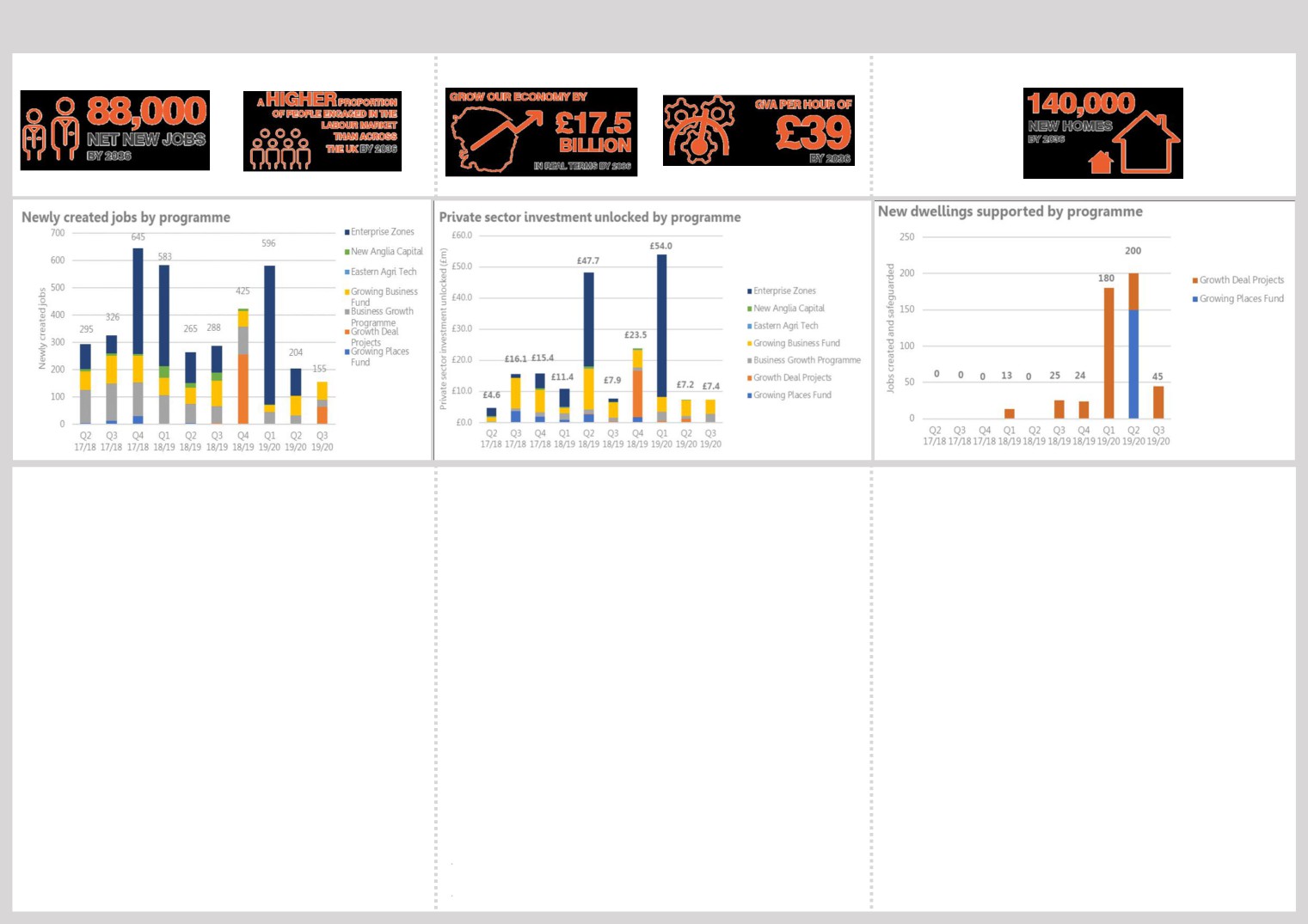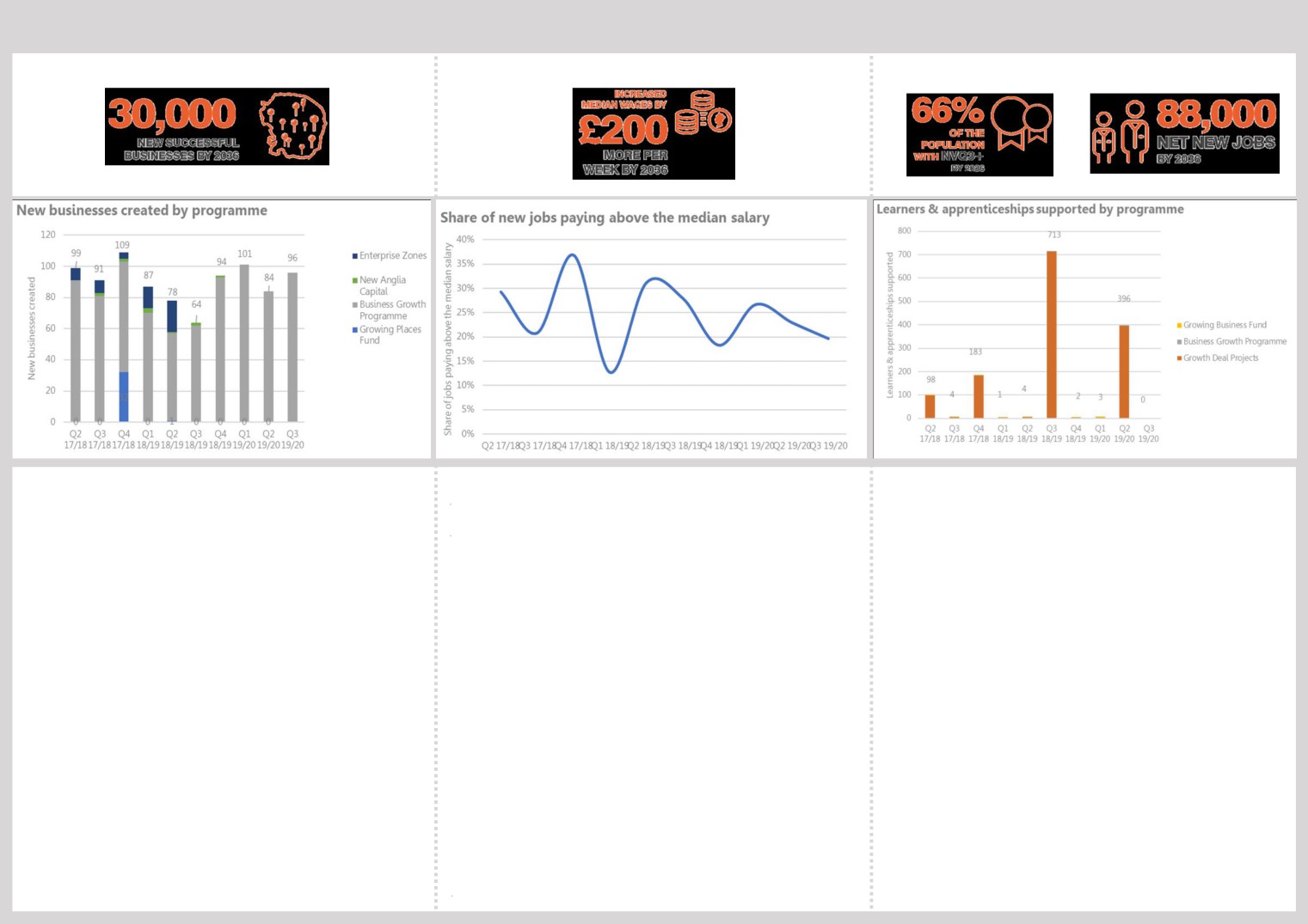New Anglia Local Enterprise Partnership Board Meeting
Wednesday 26th February
10.00am to 12.30pm
Gallery Three, Ipswich Town Hall, Cornhill, Ipswich, IP1 1DH
Agenda
No.
Item
Duration
10 mins
1.
Welcome from the Chair
2.
Apologies
3.
Declarations of Interest
4.
Welcome from Cllr David Ellesmere
5.
Actions / Minutes from the last meeting
Forward Looking
50 mins
6
Establishment of Clean Growth Taskforce and Action Plan
For Approval
7.
Approach to Developing a Tourism Sector Action Plan
For Approval
Break
10 mins
Governance and Delivery
80 mins
8.
Investment Plan Pipeline - confidential
For Approval
9.
Governance - Sub-Board Reporting
For Approval
10.
Election of Deputy Chair
For Approval
11.
Chief Executive’s Report including confidential item
Update
February Programme Performance Reports including Economic
12.
For Approval
Strategy and LEP programmes dashboards
13.
Board Forward Plan
Update
14.
Any Other Business
1
New Anglia Board Meeting Minutes (Unconfirmed)
29th January 2020
Present:
Sam Chapman-Allen (SC)
Breckland Council
Claire Cullens (CC)
Norfolk Community Foundation
David Ellesmere (DE)
Ipswich Borough Council
Doug Field (DF)
East of England Coop
Pete Joyner (PJ)
Shorthose Russell
Helen Langton (HL)
University of Suffolk
Dominic Keen (DK)
Britbots
Corrienne Peasgood (CP)
Norwich City College
Andrew Proctor (AP)
Norfolk County Council
Johnathan Reynolds (JR)
Opergy
Sandy Ruddock (SR)
Scarlett & Mustard
Alan Waters (AW)
Norwich City Council
Jeanette Wheeler (JW)
Birketts
Tim Whitley (TW)
BT
Attendees
Shan Lloyd (SL)
BEIS
Hannah Grimes
Norfolk County Council
James Allen (JA)
New Anglia LEP - For Item 7
Chris Dashper (CD)
New Anglia LEP - For Item 13
Lisa Roberts (LR)
New Anglia LEP - For Items 8 and 9
Chris Starkie (CS)
New Anglia LEP
Rosanne Wijnberg (RW)
New Anglia LEP
Helen Wilton (HW)
New Anglia LEP
1
3
Actions from the meeting: (29.01.20)
Local Industrial Strategy - Investment Plan
The tactical pipeline of projects to be produced and reported to the board
LR
The development of the Investment Plan to be reported to the Board on a regular basis
LR
Evaluation Framework
The option of employing someone to carry out evaluations to be investigated
LR
Board Recruitment
Details of job board vacancies to be circulated to Board members for onwards promotion
CP
1
Welcome from the Chair
Doug Field (DF) welcomed everyone to the meeting and thanks Ali Clabburn (AC) from Liftshare for
hosting the meeting.
2
Apologies
Apologies were received from Lindsey Rix, John Griffiths, Steve Oliver and Matthew Hicks.
3
Declarations of Interest
Full declarations of interest can be found at http://www.newanglia.co.uk/about-us/the-board.
Item 13: January Programme Reports: New Anglia Capital Report: DF declared an interest in Nova
Farina and SupaPass.
4
Welcome from Liftshare
AC, CEO of Liftshare, welcomed the LEP Board to Liftshare. The Board were provided with a
presentation highlighting the volumes of empty seats in cars when commuting and the
progress that Liftshare are making in working with organisations to fill that excess capacity.
AC noted that commuting was now the highest source of carbon emissions and that Liftshare
had set a target of saving 1bn miles by the end of March 2020 and that this target would be
reached during February.
Liftshare are working with companies to join them to the network to reduce numbers of
journeys thus saving on emissions, reducing costs and freeing up parking all of which has
been proven help with recruitment.
AC was pleased to confirm that Liftshare had been awarded the Queen’s Award for
Enterprise for the second time and the Board congratulated him on the achievement.
5
Minutes of the last meeting 27th November 2019
Two typing errors were corrected in the attendees’ details.
The minutes were then accepted as a true record of the meeting held on 27th November
2019.
Actions from last meeting updated as follows:
Chris Starkie (CS) advised that the outstanding actions relating to Enterprise Zones were
covered in the report which annexes the January Performance Report.
6
Aims & Objectives for the Year
The Board received an update from CS which reviewed progress and key deliveries over the
past year and identified the key areas the LEP would be focussing on in 2020 under the
headings implement, promote, deliver and strengthen. The presentation also covered the
external drivers which the LEP needs to take into account when planning for the year ahead
which can be grouped under the areas of Brexit, the focus on the North and Midlands, the
devolution white paper and the future funding landscape.
The Board agreed:
To note the content of the presentation
To support the themes identified as areas of focus for 2020
7
Brexit Impact Report
2
4
James Allen (JA) presented the updated Brexit Intelligence report which explores the
implications for Norfolk and Suffolk of the two possible scenarios of a withdrawal agreement
with a trade deal and a no deal situation. It sets out implications and responses for
consideration as part of delivery plans for the Economic Strategy and Local Industrial
Strategy.
JA proposed that a light touch action plan be produced which will be reported back to the
Board on a bi-monthly basis.
Implications and responses to consider have been set out under the consistent headings of
workforce, funding and investment, trade and regulation, the majority of which are consistent
with the implementation plans in place for the Economic Strategy and Local Industrial
Strategy.
Jeanette Wheeler (JW) noted that there was a large gap in the technology developed for the
agri-food industry and that used on large estates around the region and suggested that the
LEP could work with the agritech industry to support the implementation of these innovations
on the ground.
Pete Joyner (PJ) proposed that, due to the size of the issue and the difficulties in influencing
Government policy, the LEP should focus on providing practical support for affected
companies.
Johnathan Reynolds (JR) suggested that work was needed in mapping supply chains across
Norfolk & Suffolk to help businesses target and win large contracts by demonstrating local
capacity.
The Board agreed:
To note the content of the report
To agree that its recommendations are used to influence the implementation plans for the
Economic Strategy and Local Industrial Strategy
8
Local Industrial Strategy - Investment Plan
Lisa Roberts (LR) presented the Board with the designed version of the Norfolk and Suffolk
Local Industrial Strategy (LIS) employing the Norfolk and Suffolk Unlimited branding.
The Board agreed the following amendments:
Descriptions to be added to all photos for consistency
Hethel signage to be updated
Adastral Park to be included as a High Potential Opportunity (HPO)
JW asked that impact publishing the LIS would have. Shan Lloyd (SL) confirmed that it would
ensure Government buy in at a senior level and would provide support when highlighting
projects and targeting investment at a ministerial level.
The Board were asked for approval of the proposed approach and timeline for developing the
Investment Plan.
The Board requested that details of the tactical projects pipeline be included in the plan and
shared with the board as well as the strategic longer term projects.
DF expressed concern that the proposed timescales were too long & asked if priority projects
could be identified and progressed while the consultation continues.
Rosanne Wijnberg (RW) confirmed that there was a tactical pipeline which could be slotted
into the timeline immediately.
ACTION: The tactical pipeline of projects to be produced and reported to the board at the
LR
March meeting.
Claire Cullens (CC) advised that the members of the Skills Advisory Panel (SAP) were keen
to be involved and wanted to understand which projects could be included and the right
approach to take when identifying them.
3
5
LR confirmed that the investment plan needed to contain both capital and revenue projects
and should include shovel ready projects. They should also include those which are longer
term but have business cases in place should funding be made available.
CS reiterated that this plan was looking at new aspirational projects as much of the pipeline
contained projects which had been around for some time.
JR queried whether the LEP can be smarter at identifying funding opportunities and be more
proactive in employing them. LR confirmed that work is ongoing to identify sources of funding
and will produce a one-page summary of each which can be publicised when opportunities
become available.
The Board agreed:
To note the content of the report
To approve the designed version of Norfolk and Suffolk Local Industrial Strategy
To approve the approach and timetable for developing the Investment Plan and supporting
tools with regular updates provided to the Board
To receive details of the tactical projects pipeline at the March meeting
9
Evaluation Framework
LR presented the Board with the revised Evaluation Framework, the programme of evaluation
and the proposed approach to implementing the framework. The proposal includes using a
call-on, call-off list of companies that will provide external, independent support in the evaluation
process.
LR advised that the framework sets out a more robust approach to evaluation and ensures
that it is also embedded at the design stage of projects and programmes.
LR also confirmed that the Enterprise Advisor Network would be evaluated in conjunction with
the Careers Enterprise Company and would focus on the quality and not just the quantity of
the contacts provided.
Helen Langton (HL) queried whether £50k would be enough to complete the evaluations. LR
confirmed that this was based on previous evaluations and that there would be a further ask
of the Board if required.
JR asked of the £50k could be better used strengthening the LEP team by employing
someone to complete the evaluations. LR noted this would lose the independent measure
and queried whether the skill set was available.
ACTION - The option of employing someone to carry out evaluations to be investigated.
LR
The Board agreed:
To note the content of the report
To approve the updated Evaluation Framework and programme of evaluation for inclusion
in the 2020 Local Assurance Framework
To approve the approach of having call-on, call-off list of companies that will provide
external support
To approve a £50K allocation of the Growth Deal top slice to appoint a company to carry
out an evaluation on three LEP programmes
10
Board Recruitment
DF presented the Board paper advising that there would be 2 board vacancies over the year
including that of Chair.
David Ellesmere (DE) clarified whether the new Chair was being recruited externally and CS
confirmed that Government requirements dictate that the vacancy for the Chair need to be
advertised externally but that existing private sector board members could apply.
The Board agreed that the advert needs to clarify the required time commitment of the role so
that the expectations are clear to applicants.
4
6
ACTION - Adverts to be issued to Board members for onward promotion.
CP
The Board discussed the requirements of specific sectors noting that the key LIS sectors
need to be strengthened as did ensuring the Board had access to relevant financial expertise.
It was noted that the vice-chair vacancy would be available from April and a process would be
in place to fill this role.
HL, JW, DE and PJ volunteered to assist on interviews panels.
The Board agreed:
To note the content of the report and approve the recruitment packs subject to clarification
of the required time commitments of the roles
To support and promote the opportunities
To approve the interview panels for the vacancies
11
Remuneration Committee Terms of Reference
JW presented the paper highlighting the key findings of the Gender Pay Gap Report noting
that the results were very positive and would be monitored going forwards.
The revised Remuneration Committee Terms of Reference were presented and JW
highlighted the amendment to holding the committee once a year as it only reviews the salary
of the CEO.
DE noted that gender gap was positive that but given the relatively small size of the
organisation changes in personnel could change the results significantly. The Board agreed
that other types of diversity should also be monitored.
SL noted that Black and Minority Ethnic (BME) diversity was also being looked at by
Government and should reflect the makeup of the geographical area.
The Board agreed:
To note the content of the report
To agree the revised Remuneration Committee Terms of Reference
12
Chief Executive’s Report
CS noted some of the highlights of the report and asked for questions from the board.
CS highlighted the request to transfer £4.1m from the Enterprise Zone Accelerator Fund to the
Growing Places Fund (GBF) and explained that this was because there was now insufficient
time to agree and defray funds on any co-investment opportunities before the end of the
Growth Deal in March 2021 but that £4.1m remained unallocated. The LEP is already
engaged with an applicant looking for co-investment of up to £5m and without this transfer there
are insufficient funds in the GPF budget to consider the application.
This was approved by the Board.
CS noted that Norfolk and Suffolk Unlimited had received successful coverage as part of an
item on Horecava on Look East and provided an update on the event planned for MPs on 5th
February highlighting infrastructure requirements.
CS confirmed that the Peer Review meeting with the Heart of the South West LEP had
resulted in positive outcomes largely around the sharing of information. A visit to the New
Anglia LEP has been requested which will focus on operational matters.
The Board agreed:
To note the content of the report
To approve the transfer of £4.1m from the Enterprise Zone Accelerator Fund to the
Growing Places Fund
5
7
13
January Programme Performance Reports
RW reviewed the reports for January noting that applications to the Small Grants Scheme are
still progressing well and have not slowed down and confirmed that the ESF bid has been
submitted to extend the Enterprise Advisor Network.
RW advised that the focus in 2020 will be on promoting Enterprise Zones over the next year
and noted that the annexe to the report addressed the outstanding board actions.
Andrew Proctor (AP) reviewed the New Anglia Capital report.
The Board agreed:
To note the contents of the reports
14
Quarterly Management Accounts
RW highlighted key items from the report noting that income has been received from Norfolk
and Suffolk County Councils to support the Innovative Projects Fund and the awards have not
been made yet.
Other variations were highlighted as follows:
Wages and salaries - there are variations around the timing of filling vacancies but there are
no current gaps in the team.
Innovative Projects Fund - there is a time lag on the spend.
Grants - It was assumed £30m would be paid by now however this figure is currently at £16m
paid out as claims are awaited.
The Board agreed:
To note the content of the report
15
Board Forward Plan
CS reviewed the content of the next board meeting and asked for any additional items from
the Board.
The Board agreed:
To note the content of the plan
16
Any Other Business
Tim Whitley (TW) confirmed that, as part of the High Potential Opportunities Scheme,
Adastral Park had hosted an inward investment delegation from Finland which has received
excellent feedback.
CS noted the LEP would be supporting SMEs at the Mobile World Congress in Barcelona in
March.
Next meeting:
Date and time of next meeting:
10.00am - 12.30pm, 26th February 2020
Venue: Gallery Three, Ipswich Town Hall, Cornhill, Ipswich, IP1 1DH
6
8
Actions from New Anglia LEP Board Meetings
Date
Item
Action
Update
Actioned
Target Date
By
29/01/2020
Local Industrial Strategy -
The tactical pipeline of projects to be produced and reported to the board
Included on the February Board agenda
LR
Complete
Investment Plan
29/01/2020
Local Industrial Strategy -
The development of the Investment Plan to be reported to the Board on a regular basis
To be included as a standing item within the Chief Executive's Report
LR
Complete
Investment Plan
29/01/2020
Evaluation Framework
The option of employing someone to carry out evaluations to be investigated
This option has been investigated however due to the requirement for
LR
Complete
independent evaluation it has been decided to proceed with the use of
external companies.
29/01/2020
Board Recruitment
Details of job board vacancies to be circulated to Board members for onwards promotion
Circulated to Board members
CP
Complete
25/06/2019
GE Update Report
To provide the Board with regular reporting of the pipeline of visits relating to inward
To be included in the next Inward Investment update report
DD
May-20
investment and subsequent outcomes
23/05/2019
Growth Hub Presentation
Growth Hub Annual review to be circulated to the Board when published
Review began in autumn 2019. Final report is expected in spring 2020
CD
May-20
9
New Anglia Local Enterprise Partnership
Board Decision Log 2020 - Public
Date
Decision
Decision Made
Making Body*
05/02/2020
Growing
The Panel approved the following application:
Business Fund
Focus Trovex LLP - Agreed to support
Panel
Approved Grant: £73,400
Condimentum Ltd - Agreed to support
Approved increase to the existing grant - £118,483
29/01/2020
LEP Board
The Board made the following decisions:
Local Industrial Strategy - Investment Plan
To approve the designed version of Norfolk and Suffolk Local Industrial Strategy
To approve the approach and timetable for developing the Investment Plan and supporting tools with regular updates provided to the
Board
Evaluation Framework
To approve the updated Evaluation Framework and programme of evaluation for inclusion in the 2020 Local Assurance Framework
To approve the approach of having call-on, call-off list of companies that will provide external support
To approve a £50K allocation of the Growth Deal top slice to appoint a company to carry out an evaluation on three LEP programmes
Board Recruitment
To note the content of the report and approve the recruitment packs subject to clarification of the required time commitments of the roles
To support and promote the opportunities
To approve the interview panels for the vacancies
Remuneration Committee Terms of Reference
To agree the revised Remuneration Committee Terms of Reference
Chief Executive’s Report
To approve the transfer of £4.1m from the Enterprise Zone Accelerator Fund to the Growing Places Fund
* New Anglia Local Enterprise Partnership Board, Investment Appraisal Committee, Growing Business Fund Panel, Remuneration Committee, Audit & Risk Committee
10
New Anglia Local Enterprise Partnership Board
Wednesday 26th February 2020
Agenda Item 6
Establishment of a Clean Growth Taskforce and Action Plan
Author: Lisa Roberts Presenter: Lisa Roberts
Summary
This report sets out the recommended steps needed to develop a clean growth action plan
which all partners are signed up to delivering. It provides a DRAFT action plan which is a
starting point and seeks agreement from the Board to establish a Clean Growth Taskforce
which would take the lead in developing further the Clean Growth Action Plan working with
partners across Norfolk and Suffolk and embedding clean growth into the LEP infrastructure.
Attached to the report are Appendices A, B and C.
Recommendation
The Board is asked to:
Agree to the establishment of the Clean Growth Taskforce and its terms of reference
(Appendix A).
Review the DRAFT action plan (Appendix B) and agree steps outlined in the report to
develop further.
Note the LEP team’s existing Environmental policy and action plan (Appendix c) and
agree that the Board will identify a pledge that they will deliver, and which will sit within
the LEP’s own action plan.
Background
In July 2019 the Board received a presentation from the University of East Anglia on the
Climate Change Adaption and Carbon Reduction Scoping Report and agreed to the
development of an action plan to tackle some of the key findings of the report.
In September 2019 the Board agreed to endorse and sign off the Norfolk and Suffolk Local
Industrial Strategy. The LIS has been submitted to government and is awaiting their approval.
Clean growth sits at the heart of this Local Industrial Strategy - with Norfolk and Suffolk
positioned as the UK’s clean growth region.
At the same time the Norfolk and Suffolk Unlimited brand was launched with ‘Welcome to the
UK’s Clean Growth region’ front and centre of the marketing campaign.
The LIS states our ambition to be:
A globally recognised, technology-driven and inclusive economy which is leading the transition
to a post-carbon economy through sustainable food production and sustainable energy
generation.
1
11
Norfolk and Suffolk is at the forefront of tackling the challenges and opportunities of climate
change - the area affected earliest by rising sea levels and changing rainfall pattern and with
major research and business strengths in adapting to the change.
The area’s major strengths in energy generation and usage, high tech, sustainable agri-food
present major opportunities. The cross-sector opportunities are particularly exciting, delivering
solutions such as energy self-sufficiency in farming, or using older gas platforms for renewable
energy generation, for example, to make a major contribution to the UK’s transition to a post
carbon economy.
Norfolk and Suffolk’s key strengths and assets make it well placed to be at the forefront of the
clean growth revolution.
As the UK’s leading producer of renewable and low carbon energy and a significant
producer of low carbon goods and services.
As a testbed for innovation in industries such as farming and food production,
transportation and construction which need to reduce their carbon footprint and adapt to a
changing climate.
As an area with an outstanding natural environment and natural resources which are
particularly vulnerable to climate change but where innovative new mitigation measures
and technologies are being pioneered.
As an area with a wealth of world class innovation and thinking, and exportable skills.
Along with many award-winning businesses, that are on the leading edge of a low-carbon
future.
Key Considerations
Addressing the challenges of climate change will require actions across society and by many
different organisations. Coordination of interventions and actions between sectors is critical to
achieving future clean inclusive growth.
Clean growth will not be achieved if it is not embedded within decisions, intervention
development, delivery, it is not a separate piece of work and it will take time. Changing they
way people think and work is always challenging.
The LEP can play a vital role in facilitating collaboration with partners to change the way we
work; the way decisions are made so that clean growth is considered at all stages.
Set out below are the steps that the LEP should take to bring together key partners to
collaborate, drive and implement the actions needed to ensure the areas strengths as the UK’s
clean growth region are fully realised.
1 Leadership and collaboration - Establishing a Clean Growth Taskforce whose
members will be ambassadors for the ‘UK’s Clean Growth Region’ and help drive
forward and embed the clean growth framework across Norfolk and Suffolk and beyond.
To drive forward the clean growth agenda through the existing LEP governance it is proposed
that we establish a Clean Growth Taskforce. This would sit below the LEP Board and have
representatives from existing LEP groups and others who would act as clean growth advocates.
It is anticipated that the Taskforce will be supported by existing local authority Climate Change
Partnerships subject to their formal agreement.
The purpose of the taskforce would be to embed clean growth in the development and delivery
of actions and decisions which deliver the Economic Strategy and Local Industrial Strategy.
12
2
Appendix A is a draft terms of reference for the Taskforce and provides more detail.
2 Focus - Identify and agree to focus on the actions in areas that the LEP and partners
can achieve the biggest gains and impact.
There are many contributing factors to climate change and there is a need for local partners to
identify and agree the areas that the biggest gains can be achieved, and which actions will be
focused on.
It would be the role of the Taskforce to make recommendations to the LEP Board on what
these focuses should be.
3 Evidence - Work with Government to develop and agree robust ways of measuring and
monitoring the impact of interventions and actions.
This is an objective we have discussed with Government officials during the development of the
Local Industrial Strategy. Many places and organisation have set targets and pledges which are
supported by little or volatile evidence.
To ensure our actions are ones that will make the biggest difference we will develop and agree
robust ways of measuring and monitoring the impact of interventions and actions. Which in turn
will enable us to set realistic pledges, targets and ensure the right interventions are in place.
4 Action - Work with partners develop a mitigation and adaptation clean growth action
plan which provides the right balance for sustainable economic growth.
Clean growth cannot be delivered by one partner alone or by one strand of investment or
actions. It is important that partners play a role in developing the action plan to secure their buy
in and for them to own their role in delivering it.
Appendix B is the DRAFT Norfolk and Suffolk Clean Growth action plan which is a starting point
for the Taskforce to pick up and drive.
It builds on the evidence of the Local Industrial Strategy and the Climate Change Adaption and
Carbon Reduction Scoping Report to outline the areas that Norfolk and Suffolk should consider
with respect to delivering clean growth.
They include at the highest level:
Private sector - the energy and agri-food/land management sectors in particular
Public sector - individual local authorities and local climate change partnerships
Voluntary sector - Rural Community Energy and other local funds
Infrastructure - transport, energy and water in particular
Housing - retrofitting as well as new build
Green finance - engage with and increase focus on access to.
Communications - key messages including a more holistic approach to the Norfolk and
Suffolk Energy Coast
The actions in the draft plan have come from existing activity and early discussions with some
partners.
To ensure success the plan needs developing further and refining engaging partners to ensure
they recognise their role in delivering and achieving the goals.
The next stage of developing the action plan will involve agreeing measures of success for
each of the actions which is part of the evidence work required.
3
13
New Anglia LEP Team
The LEP team wants to lead by example and is committed to environmental protection and the
minimisation of the negative environmental effects of its direct business activities. The LEP
team has its own existing Environmental Policy and action plan which is part of the staff
handbook (Appendix C).
The LEP team are keen to take this plan even further and are in the process of developing and
agreeing three pledges which the organisation will work towards during 20/21.
This is likely to include a development of a clean travel plan and reducing the number of miles
travelled by staff; reducing the use of paper and looking at how we influence our own supply
chain.
The Board are asked to consider and agree to identify a pledge that the Board will work
towards and which will sit within the LEP’s own action plan.
Next steps
The key next steps are as follows:
Establish a Clean Growth Taskforce
Spring 2020
Recruit an independent Chair
Spring 2020
Work with existing Climate Change Partnerships to gather
On going - Transport Board
additional intelligence and develop the Clean Growth Action
reviewing on 25th Feb.
Plan
Subgroups and Board to review draft action plan and provide
On going
input
First meeting of the Taskforce
May/June
Recommendation
The Board is asked to:
Agree to the establishment of the Clean Growth Taskforce and its terms of reference
(Appendix a).
Review the draft action plan (Appendix b) and agree steps outlined in the report to
develop further.
Note the LEP team Environmental policy and action plan and agree that the Board will
identify a pledge that they will deliver, and which will sit within the LEP’s own action
plan.
4
14
Appendix A - Draft Terms of Reference for Clean Growth Taskforce
Purpose of
To embed clean growth in the development and delivery of actions and
the
decisions which deliver the Economic Strategy and Local Industrial Strategy.
Taskforce:
Functions:
Members of the Taskforce will be expected to:
i. Attend meetings, contribute ideas, experience, expertise, and resource as
considered appropriate, and gather views from colleagues in respective group,
industries or organisations.
ii. Further develop the clean growth action plan for Norfolk and Suffolk
engaging relevant partners to securing their buy in to deliver the action plan,
through respective groups and networks.
iii. Identify and recommend to the LEP board the areas of focus that the biggest
gains can be achieved, and which actions will be focused on.
iv. Promote Norfolk and Suffolk as the UK’s Clean Growth Region helping to
raise the profile of the major contribution the area plays in the UK’s transition to
a post carbon economy, representing the area national, regionally and locally.
v. Ensure clean growth is embedded in the discussion, actions and decision of
your respective group, reporting back to the taskforce as appropriate.
vi. Recommend or source appropriate experts to inform certain aspects of the
action plan, convene working groups as appropriate and consult with sector
peers as agreed within the Taskforce under the direction of the Chair.
vii. Oversee the development and agree robust ways of measuring and
monitoring the impact of interventions and actions, making recommendations to
the LEP board on any relevant targets or pledges.
viii. provide the LEP Board with quarterly progress reports.
ix. Annually, bring together the wider network of clean growth champions to
share knowledge and best practice.
Membership:
The taskforce would have an independent chair and be accountable to the LEP
Board.
Each LEP sub board would nominate a representative - LEP Board, LEP’s
three industry councils, Innovation Board, Skills Advisory Panel, Transport
Board and Investment Appraisal Committee. In addition there would be eight
representatives invited to join from Business intermediaries, Local Authorities,
the Environment Agency and the Voluntary sector.
Frequency
The taskforce would initially meet every 6 to 8 weeks to drive the development
of the action plan; once developed meetings would be quarterly.
Accountability
The taskforce would report to the LEP Board.
Reporting
The agenda and minutes of meetings will be published on the LEP website and
procedures
the taskforce will report to the LEP Board through the sub board reporting
mechanism.
Attendance of
Members of the LEP team, sub boards, committees and Local Authorities may
non-members
also be invited to attend meetings where appropriate.
at meetings
Delegated
Can hold other groups - including Task and Finish groups - to account. It has
Authority
the authority to task a sub-board, group or committee to deliver action within
15
5
the delivery plan.
Where the Taskforce convenes working groups, it should set out the terms of
reference for the working group to guide its objectives, ways of working,
handling of information and the rules on external communication.
Managing
Members of the Taskforce are all representatives of their industry sector or
Conflicts of
community of interests and have a responsibility to act on behalf of their wider
Interest
constituency at all times in relation to the work of the LEP Clean Growth
Taskforce.
Members of the board will be asked to complete an annual declaration of their
interests which will be held in a register at the LEP office and members will be
asked at the beginning of each meeting to declare any conflicts of interest
pertaining to the agenda items to be discussed.
Review
The ToR of the Taskforce will be review annually and agreed by the LEP board.
6
16
Item 6 Appendix B is the DRAFT Norfolk and Suffolk Clean Growth action plan
Context
This DRAFT action plan is a starting point for the Clean Growth Taskforce to pick up, develop and drive forwards, working with partners. It
builds on the evidence of the Local Industrial Strategy and the Climate Change Adaption and Carbon Reduction Scoping Report to outline the
areas that Norfolk and Suffolk should consider with respect to delivering clean growth.
The actions in this draft plan have come from existing activity and initial discussions with partners. To ensure success the plan needs
developing further and refining engaging partners to ensure they recognise their role in delivering and achieving the goals.
The next stage of developing the action plan will involve agreeing measures of success for each of the actions which is part of the evidence
work required.
Industrial Sector
Background
The Government’s clean growth strategy demonstrates a clear understanding of the potential for cost-effective
energy efficiency in the commercial and industrial sector, adding that £6 billion could be saved in 2030 through
investment in cost-effective energy efficiency technologies.
There are various funding pots to support businesses in improving their energy efficiency. Nationally, the Carbon
Trust Green Business Fund is dedicated to supporting SMEs and providing opportunities to improve energy
efficiency and reduce energy costs. This fund has supported thousands of small businesses to identify an
average potential saving of £8,320 on their energy spend.
Norfolk and Suffolk
The industrial sector accounts for 34% of all carbon dioxide emissions in Norfolk and Suffolk.
Context
The Business Energy Efficiency (BEE) Anglia programme provides free support to eligible organisations across
Norfolk and Suffolk to help them become more energy efficient with independent expertise, Carbon Charter
accreditation and grant funding available up to 40% of total project costs (or up to £20k).
Business intermediaries and networks are actively supporting businesses across the region, with a range of
activities planned throughout 2020 and manifesto pledges. Highlights include Innovate UK’s event at Norwich
Research Park in March, various Chamber events across the region and CBI’s Net Zero event with the UEA in
May.
Data available
Industrial business energy use
(include baseline if
Emission intensity of industrial business energy use
have)
Number of businesses with carbon chapter accreditation
Recycling and materials efficiency monitoring data
Rate of clean energy supplier usage
Projects to install energy generation (e.g. solar panels) as part of facilities management approach
1
17
Assessment of the age (and associated energy efficiency) of plant and machinery involved in major
manufacturing processes
Action
Responsible /
Deadline/
Result
Resources
Potential
Status
milestones
barriers
Explore the expansion of
LEP Executive &
March 2021
Potential to roll out on a wider
BEE Anglia
Future of
existing business
Growth Hub
basis and for the Growth Hub to
UEA
Funding
resilience / resource
have a suite of projects to signpost
Chambers of
efficiency services
to on clean growth.
Commerce
Build momentum with
LEP Executive
March 2021
Case studies of businesses leading
Chambers of
business intermediaries
the way will help encourage others
Commerce
and networks to enhance
to do the same and in turn enhance
FSB
business
the Norfolk and Suffolk Unlimited
CBI
awareness/understanding,
brand.
IoD
disseminate best practice
Understanding of specific local
Local
and source case studies
challenges and opportunities and
authorities
particular sector vulnerabilities
Assess how we can
LEP Executive &
March 2021
Assessment of LEP programmes to
Evidence
Need business
further support
Growth Hub
ensure they support our clean
behind CO2
buy-in
businesses (including our
growth ambitions as a region.
report which
largest emitters) in
highlights
mitigating impacts
largest emitters
Ensure clean growth is
Norfolk and Suffolk
Ongoing
Cements Norfolk and Suffolk’s
LEP
central to the region’s
Unlimited
position as the clean growth region
Local
focus on inward
authorities
investment
Energy Sector
Background
Government’s clean growth strategy sets out the ambition to drive towards clean energy with
emissions from the power sector close to zero by 2050. The document sets out the ambition that we
may even see negative emissions from the sector if sustainable bio-energy and carbon capture and
storage are used together.
Norfolk and Suffolk Context
With the highest concentration of nationally significant energy projects, Norfolk and Suffolk play a key
role as a leading generator of renewable energy.
2
18
Clean energy has been identified as one of the three strategic opportunities set out in Norfolk and
Suffolk’s Local Industrial Strategy, given the potential for economic growth, productivity
enhancements and importantly the direct links to the golden thread of that strategy, clean growth.
Data available
Emissions from generation
(include baseline if have)
Share of generation from clean sources
Proportion of private/industrial/public sector energy users specifically sourcing a ‘clean energy’
provider
Action
Responsible /
Deadline/
Result
Resources
Potential
Status
milestones
barriers
All Energy Industry Council takes a
All Energy
Quarterly
Norfolk & Suffolk’s all energy
ORE Catapult
leadership role in driving clean
Industry Council
meetings
cluster widely recognised as a
Inward
growth across the Norfolk and
- formed and
leader in innovative clean
Investment
Suffolk energy cluster.
meeting
technology and emissions
regularly
reduction
Increase evidence around the
LEP Executive
Supply chain
Energy Sector Capability matrix
All Energy
Needs all
energy sector’s supply chain and
mapping
Evidence around the carbon
Industry Council
partners
capabilities and explore
work
footprint of the sector
East of England
to buy-in
opportunities to reduce the sector’s
commencing
Energy Group
carbon footprint
early 2020
Drive forward carbon capture and
All Energy
March 2021
Adoption of innovative new clean
East of England
storage; solar; tidal; onshore; and
Industry Council
technologies across the energy
Energy Group
biofuel; as well as other ‘new
sector and the determination of
ORE Catapult
process’ opportunities - scoping to
start-up support needed
Innovation Board
determine start-up support as well
& Forum
as technology adoption
Growth Hub
Improve evidence around the
LEP Executive
March 2021
Enhanced evidence base and
electrical needs for future changes
awareness of future electrical
(e.g. EVs, heat, digital connectivity,
needs for Norfolk and Suffolk
interconnected home)
Expand current sector hubs /
Innovation
Ongoing
Clear and strong links between
All Energy
incubators / grow-on spaces as
Board
hubs
Industry Council
necessary and link to innovation
Development of low carbon
Innovation Forum
hubs
innovation hubs (LIS intervention)
3
19
Green sector
Background
Green sector jobs growth has outperformed growth in the wider economy recently and there is significant opportunity
to drive further jobs growth in the sector in the years to come given the current emphasis being placed on clean
growth and zero carbon nationally.
Norfolk and Suffolk
Norfolk and Suffolk are well placed to take advantage of this opportunity given our clean growth focus. Skills
Context
developed locally can be marketed to other regions seeking to decarbonise in the future.
Data available
As above
(include baseline if
have)
Action
Responsible /
Deadline/
Result
Resources
Potential barriers
Status
milestones
Green finance
LEP Executive
Ongoing
Better understanding of opportunities
LEP
Scale of opportunity
opportunities to be
for the green sector as well as the
Executive
explored
wider economy
Others - tbd
Public Sector
Background
In December 2015, the United Nations Climate Conference met in Paris to agree the first-ever universal, legally binding
global climate change agreement. This set out a global framework to avoid dangerous climate change by limiting global
warming to well below 2oC and pursuing efforts to limit it to 1.5oC. The deal also aims to strengthen countries’ abilities
to deal with the impacts of climate change and support them in their efforts. The UN COP26 Conference takes place in
Glasgow from 9-20th November 2020.
In June 2019, the UK government became the world’s first major economy to pass laws to end its contribution to global
warming by 2050. This target requires the UK to bring all greenhouse gas emissions to net zero by 2050, compared
with the previous target of at least 80% reduction from 1990 levels.
The clean growth strategy was published in 2017 as part of the national Industrial Strategy. Ministers said in
September 2019 that this strategy was in line for a significant refresh to help meet the new 2050 net zero target.
Highly ambitious local government leaders have set up a network, UK100, which pledges to secure the future for their
communities by shifting to 100% clean energy by 2050.
Norfolk and
The following local authorities have declared climate emergencies across the region: Norfolk - Breckland; North
Suffolk Context
Norfolk; Suffolk - Babergh and Mid-Suffolk; East Suffolk; Ipswich Borough; West Suffolk; and Suffolk County.
Norwich City Council is currently the only local authority signed up to the UK100 network.
Norfolk County Council haven’t declared a climate emergency however at the end of November 2019 announced a
package of £1m for capital projects and £350k for revenue projects to deliver against the 2030 target. An
Environmental Policy has been published by the County Council with a number of ambitious objectives, which will
guide all future decisions and ensure that the County at large goes beyond the net zero carbon target.
4
20
Suffolk’s local authorities are working collectively, alongside the University of Suffolk and Environment Agency, through
the Suffolk Climate Change Partnership to make the county carbon neutral by 2030. The partnership will publish an
updated action plan this year to analyse existing, publicly available data and related tools to provide a clear, evidence-
based baseline of carbon emissions in Suffolk per key sector and then set out indicative emissions reduction pathways
per key sector to meet the carbon neutral by 2030 target. The partnership is developing their own policy responses to
the climate emergency declarations.
Data available
Emissions intensity of non-industrial business and public energy use
(include baseline
Non-industrial business and public energy use per £ million output
if have)
Set targets for reduction in private car mileage for public sector activities?
Action
Responsible / Status
Deadline/
Result
Resources
Potential barriers
milestones
Encourage local
LEP Board
As soon as
Greater awareness of the
Local authorities
Climate
authorities to sign
possible
emergencies declared across
emergencies have
up to the UK100
Norfolk and Suffolk and
not been declared
Network
activities driving clean growth
across every local
authority yet
Effective
LEP Executive
Expected -
Showcase positive case studies
LEP Comms team
Prime Minister
communications
May 2020
from across various sectors
Industry Councils /
needs to sign off on
plan during Green
Sector Groups
this date, so may be
Great Britain week
postponed
Strong public-
LEP Executive
Ongoing
Ensure that activity at county
Partner buy-in
private
and district level aligns with the
required to avoid
collaboration to
needs of the private sector and
overlaps as partners
deliver progress
key parties are involved as
move forward with
activities progress at the local
local activities
level
Voluntary, Community & Social Enterprise Sector
Background
There are various national and local initiatives/funds that aim to support local communities in their efforts to deliver
sustainability and tackle climate change.
The Rural Community Energy Fund is a £10 million programme which supports rural communities in England to
develop renewable energy projects, which provide economic and social benefits.
Norfolk and Suffolk
Across Norfolk and Suffolk, there are a range of local and national environmental charities which seek to enhance
Context
our natural capital and prioritise climate mitigation. Most of these charities have declared climate emergencies and
are playing an important role in tackling climate change.
5
21
The Sheringham Shoal Community Fund is a good example of offshore wind farm developers working with local
communities to fund projects that deliver against one or more objectives, including climate mitigation and the
promotion of environmental sensitivity or the benefits of renewable energy.
King’s Lynn & West Norfolk Borough Council has created a new small grants fund to tackle two specific issues
across the community - the reduction of single use plastics and voluntary action to clear the community of litter.
Data available
Tracking of projects and associated outcomes/outputs the VCS sector is engaged in - including direct
(include baseline if
carbon emission reductions, power generation volumes, ‘green skills’ initiatives, and materials efficiency and
have)
recycling
Action
Responsible /
Deadline/
Result
Resources
Potential barriers
Status
milestones
Engage the VCSE
VCSE Sector
These two groups
Importance is high on the
Local
Large sector with
sector leadership
Leadership Groups
meet regularly
agenda for the sector at large -
authorities
various constraints
groups for Norfolk and
for Norfolk and
pulling together measurable
Suffolk to establish
Suffolk
actions and case studies of
measurable actions
community action
Infrastructure: Transport
Background
Given the significant contribution the transport sector plays in emissions it is critical that we consider how it can
reduce its contribution over time.
The Government’s ‘Road to Zero’ strategy stated that the UK will end the sale of new conventional petrol and diesel
cars and vans by 2040. Since its original publication in 2018 this target has been reviewed and brought forward to
2035.
Norfolk and Suffolk
38% of carbon emissions in Norfolk and Suffolk are from the transport sector. In 2005 this proportion was only 29%.
Context
While transport emissions have reduced over time, other sectors have observed greater reductions hence the
proportion of emissions from transport has actually increased.
Data available
Understanding emissions by mode, vehicle type, journey distance and journey type, and transport inter-
(include baseline if
connectivity (business or leisure) would add further knowledge to how successful interventions may be.
have)
Any additional data on the provision of adequate levels of broadband connectivity, especially in rural locations
- to enable more widespread working from home/closer to home options
Potentially ask for LA planning authorities to provide their assessments of EV charging point connectivity and
projected public EV charge point connectivity schedules and requirements
Action
Responsible /
Deadline/milestones
Result
Resources
Potential
Status
barriers
Imbed clean growth
All
Ongoing
Clean growth
Existing budgets
Acceptance of
ambitions in
In development
considered as part
should cover this as it
challenging
6
22
transport strategies
LEP Board tasked Transport
of the overall
is a shift in focus.
ambitions/
and policies
Board with this in Nov ‘19.
decision-making
Additional evidence
targets in this
County Councils LTPs
process with
may be needed in
area.
currently in review.
respect to
support of this action.
transport.
Reduce the need to
County Councils
95% superfast broadband by
More people able
tbd
Rural delivery
travel through better
In development/
2020.
to work flexibly and
challenges.
digital connectivity
delivery
Full fibre coverage by 2025.
on the move,
and flexible working.
Better mobile connectivity
boosting
The internet of
ASAP inc. 5G pilots.
productivity as well
things can also help
as inclusive and
drive efficiencies.
clean growth.
Improve access to/
County Councils
County Councils LTPs
More people
Ongoing business
Reliance on the
use of sustainable
In development/
currently in review.
encouraged to use
case development in
private car in
modes/models
delivery
Ongoing work/ delivery in
sustainable modes
this area in order to
rural areas
through integration
urban areas.
as access to and
secure funding.
although
and behaviour
Ongoing work on road network
ease of use
opportunities for
change
to reduce congestion/ improve
improves.
car sharing and
air quality.
Reduced
cleaner vehicles.
Transforming Cities and Future
congestion helps to
Mobility Zone bids for Norwich.
support clean
Ongoing work to improve rail
growth ambitions.
freight and passenger
connectivity inc. Sizewell C.
Work with the CPC
Transport Board
Blue tech proposal with Port of
Increased transport
tbd - possible
Encouraging
to drive transport
In development
Felixstowe and BT - ongoing.
innovation and best
Innovative Projects
those who are
innovation and
Connections Café on 25
practise spreading
Fund bid.
not already
support for SMEs
February.
within the sector.
engaged to get
involved.
Develop an EV
tbd
tbd
Greater take up of
tbd - Greater South
Rural networks.
strategy focussed on
Concept
EVs/lower
East Energy Hub
supporting
emissions vehicles
doing some work in
infrastructure as well
this area.
as take up
Consider freight and
tbd
tbd
tbd
tbd
tbd
air as modes/ types
Concept
7
23
for further
exploration
Air quality
LAs
Ongoing
Improvements in
Existing
Increased urban
improvements
In development/
air quality
transport
delivery
Increase
Infrastructure
Ongoing
More resilient
tbd
Resource
infrastructure
providers
infrastructure
resilience
In development/
delivery
Infrastructure: Energy
Background
It is critical that we consider non-traditional methods of solving the future energy challenge with local energy being
at the heart of this.
Norfolk and Suffolk
At present, there are significant capacity constraints on the electricity distribution network in many parts of Norfolk
Context
and Suffolk. Added to that we have a significant national energy asset in our Energy Coast which needs to be
considered strategically.
Work has already begun in this arena in the shape of the Local Energy East Strategy commissioned alongside the
Greater Cambridge Greater Peterborough and Hertfordshire LEPs. Indeed, the Greater South East Energy Hub
established by BEIS is tasked with increasing the number, scale and quality of local energy projects and their
delivery. As a later addition, the Hub is also responsible for determining the Rural Community Energy Fund which
has been underutilised to date in Norfolk and Suffolk.
Data available
Please see above under ‘Energy’ heading
(include baseline if
have)
Action
Responsible /
Deadline/
Result
Resources
Potential barriers
Status
milestones
Develop a strategy to
tbd
tbd
More local energy solutions,
tbd
Resources
over grid constraints
Concept
energy generators matched
with high users and better
utilised planning policy
Develop a strategy to
tbd
tbd
More local energy solutions,
tbd
Resources
decarbonise heat
Concept
less reliance on oil, reduction
in fuel poverty
8
24
Develop an investment
New Anglia LEP
tbd
Better disseminated
tbd
Resources
prospectus covering
Concept
information and more upfront
electricity and heat
investment
opportunities
Investigate the
New Anglia LEP
tbd
More resilience and less
tbd
Resources - likely to
extension of HV
Concept
impact on local communities/
be significant
transmission network to
businesses
coast inc. potential for
offshore solution
Reduce energy
All
ASAP
Less demand for energy
tbd
Resources
demand and increase
Concept
energy efficiency
Boost applications to
Greater South
Ongoing
More rural community energy
tbd
Promotion
RCEF
East Energy Hub
schemes
Delivery
Consider future power
New Anglia LEP
tbd
EVs, a more digitally
tbd
Resources
needs
Concept
connected, smart economy
and the decarbonisation of
heat included
Infrastructure: Water
Background
Improved water management needs to be a priority for coming decades, both in terms of increased storage
capacity and greater use efficiency. The Water Resources East partnership initiative provides an excellent wider
regional platform for planning game-changing initiatives in this area.
Norfolk and Suffolk
The ambitious plans for both the Norfolk Water Resources Management Plan and the Suffolk Holistic Water
Context
Management Project are a good starting point in our area.
Data available
tbc
(include baseline if
have)
Action
Responsible /
Deadline/milestones
Result
Resources
Potential barriers
Status
Develop and deliver a
In development -
Projects in
Holistic solutions to
Investments in
Need to secure
regional sustainable
a number of
development in 2020 -
water management
feasibility, capital
funding and need to
water management
collaborative pilot
Regional Management
maximising the
build, data capture
focus ambitious
plan, in particular
projects are
Plan 2023
resources we have,
and testing
agenda on
9
25
addressing water
underway in
and ensuring
deliverable
access issues, water
Norfolk and
adequate supply
initiatives. Long term
capture and storage
Suffolk - Water
timescales for some
and the potential for
Resources East
projects.
water trading
and partners
Infrastructure: Flooding - section to be developed
Housing
Background
While we must ensure all new build meets the challenge of achieving clean growth it is critical to acknowledge that
much of our housing stock is old, energy inefficient and needs a significant retrofit programme in order to
contribute to this agenda.
Norfolk and Suffolk
28% of carbon emissions in Norfolk and Suffolk are from the domestic sector.
Context
Data available
Home Energy Use per household
(include baseline if
Emissions Intensity of home energy
have)
Share of homes with EPC
Understanding the impact of new build versus retrofit, and to what standard, would be useful information to gather,
particularly the scale of additional qualified labour required to achievement installation targets and associated costs
for the consumer/business.
Action
Responsible /
Deadline/milestones
Result
Resources
Potential barriers
Status
Increase energy
Construction
tbd
Reduced energy use
tbd
Resources and
efficiency and use the
industry
challenging
most of natural
In development
timescales
resources in new and
old stock
Decarbonise heating
Greater South East
No new fossil fuel
Reduced carbon
tbd
Resources and
Energy Hub(?)
boilers post 2025
emissions
challenging
In development
timescales
Use of more
Construction
Ongoing
Increased efficiency
tbd
Resources
sustainable and
industry
innovative
In development
materials/methods
10
26
Promote the whole life
tbd
tbd
Better
tbd
Challenging
benefits of sustainable
Concept
understanding
perceptions
homes
Imbed sustainable
Planning/
ASAP
Higher quality, more
tbd
Resources and
quality in the early
construction
sustainable homes
challenging
development stages to
industry
perceptions
reduce costs
Concept
Influence legislation to
New Anglia LEP/
tbd
More sustainable
tbd
Resources
include more
local authorities
homes
sustainable measures
Concept
Consider how planning
LPAs
Ongoing as part of
More sustainable
tbd
Other considerations
policy can contribute to
In development
Local Plan reviews
growthh
to be taken into
the clean growth
account
agenda
Natural capital, agriculture, food processing and land management
Background
The Agriculture Bill and Environment Bill being considered by Parliament propose far-reaching changes to the way
we manage our land and the value placed on particular interventions. The Agriculture Bill proposes a future
emphasis on ‘public money for public goods’ with funding potentially linked to actions which protect biodiversity,
increase woodland, improve soils and protect natural habitats. The Environment Bill potentially supports this with
the proposed creation of Nature Recovery Networks to improve and connect key habitats, and the importance
placed on valuing Natural Capital.
These changes could provide a funding landscape which enables significant environmental benefits. However,
Basic Payments are being phased out for farmers, and decisions on our future trading relationships are critical for
the sector, so there could be challenges in ensuring productivity and growth alongside environmental gains.
Norfolk and Suffolk
Improved water management needs to be a priority for coming decades, both in terms of increased storage
Context
capacity and greater use efficiency. The Water Resources East partnership initiative provides an excellent wider
regional platform for planning game-changing initiatives in this area, and the ambitious plans for both the Norfolk
Water Resources Management Plan and the Suffolk Holistic Water Management Project, which aims to capture
pumped drainage water for agricultural and domestic use, are a good starting point in our area.
Improvements in water management also support improved soil quality, which is needed to enable sustainable
agriculture, and to improve biodiversity and carbon sequestration. This area is currently being explored with Water
Resources East and a number of landowners, and potential projects are being developed.to address the soil
improvement challenge in a water management context.
Opportunities will exist for landowners and managers to contribute to carbon sequestration - the proposed Natural
Capital East regional initiative and other 25 Year Environment Plan activity will help develop the evidence base that
11
27
is needed to prioritise carbon sequestration where it makes the most economic and environmental sense. The
Eastern Claylands project from the Woodland Trust is an ambitious initiative already working on this challenge.
An ever-changing landscape in the funding of local renewable generation of heat and power will provide
opportunity for landowners and public bodies to develop renewable generation projects. Making the relevant
funding and support information widely available will support this aim.
Data available
A number of carbon and soil health tools available - many challenges with extrapolating data in a
(include baseline if
meaningful way from micro to farm or landscape scale (see actions below).
have)
Natural Capital Baseline assessment for Norfolk and Suffolk being developed by UEA for Norfolk and
Suffolk County Councils using the indicators in the Government’s 25 Year Environment Plan - due to be
completed early 2020.
Action
Responsible / Status
Deadline/milestones
Result
Resources
Potential barriers
Develop a Natural
Being delivered - UEA
Initial baseline
A robust baseline with
Existing data from
None
Capital baseline
/NCC/SCC and key
completed May
data against many of
a wide range of
assessment for Norfolk
environment/ farming
2020
the measures in the
sources, checked
and Suffolk to inform
stakeholders plus the
25 Year Environment
and analysed by
future planning
LEP
Plan
UEA
Explore the potential to
In development - LEP
Develop initial
Region wide initiatives
Project
Need to separate
develop regional
and other partners
projects with WRE
are developed and
development time
out clearly
natural capital
actively working with
in 2020; scope the
secure funding
initially
deliverable projects
enhancement and
Water Resources East
Natural Capital East
resource management
on a range of ideas,
initiative during
projects with the
and the LEP part of the
2020
proposed Natural
steering group for
Capital East initiative
Natural Capital East
and Water Resources
East
Develop and test data
In development - LEP
Develop project by
A robust methodology
On-farm costs of
Need to secure
assessment
with data specialists,
summer 2020
to propose to Defra
testing methods,
funding - fast
methodology for
UEA and leading local
and a case for the
data capture and
moving and
comparing the carbon
farmers
value of improving
analysis tools and
competitive field.
sequestration and soil
carbon sequestration
process, academic
quality benefits of a
on productive land.
input.
range of measures.
Develop biodiversity
Water Resources East,
Aim to have some
Habitat improvement,
Cost of landscape
Many smaller
and water
key environmental
developed initiatives
improved water
interventions,
projects delivered -
quality/resource
groups, NCC/ SCC and
in 2020
quality and water
measuring and
12
28
projects in river
the farming sector -
resource
monitoring
challenge of
catchments and wildlife
concept stage but
management, new
equipment and
delivering at scale
corridors and marginal
some projects in initial
and transferable
data analysis, and
land
development stage
methodologies and
project
partnership
management
approaches
Deliver a new Food
Funding bids under
Results of bids
Increase in innovation
Capital build of
Need to secure
Innovation Centre to
consideration - SNDC
2020, project 2021-
in the food sector in
new centre, and
funds
support food sector
and partners
23.
Norfolk and Suffolk
revenue
businesses to innovate,
and the development
programme of
tackle food and health
of an agrifood cluster
support.
challenges, and
aware of and tackling
develop new products,
clean growth agenda
in the context of clean
growth
Develop and deliver
In development - a
Projects in
Holistic solutions to
Investments in
Need to secure
sustainable water
number of potential
development in
water management
feasibility, capital
funding, and need to
management plans for
projects under
2020 - Regional
maximising the
build, data capture
focus ambitious
Norfolk and Suffolk, in
consideration for
Water Management
resources we have,
and testing
agenda on
particular addressing
funding /further
Plan 2023
and ensuring
deliverable
the water access
development - Water
adequate supply
initiatives. Long
issues around
Resources East and
term timescale for
abstraction, water
partners
some projects
capture and storage on
drained land, and the
potential for water
trading
Green Finance
Background
Green Finance is one of the fastest changing areas of funding opportunity, with a menu of grant, loan and
equity options for private and public sectors, with different packages in terms of project management and
delivery, risk management, and returns. However, there is still an issue with resourcing the development of
new project ideas and testing their feasibility.
Norfolk and Suffolk
There is a growing range of finance options with the potential to enable the delivery of clean growth projects.
Context
The European Regional Development Fund has supported a number of projects which provide grants, advice
or equity investment to projects which deliver carbon savings -
13
29
BEE Anglia, £4.1m low carbon specialist assessment and grants programme run by Suffolk County
Council and supported by the ERDF programme, operates across the LEP area and has enabled carbon
savings in participating businesses.
Low Carbon Innovation Fund 2, a regional equity investment opportunity co-financed with £8m ERDF
funding, and run by UEA and Norfolk County Council, offers low carbon investment opportunities for
businesses in the East of England.
Eastern New Energy - a multi-LEP project starting in 2020, with just under £1m allocated to Norfolk and
Suffolk activity, run by the University of East London, with UEA and the University of Suffolk among its
partners. It will work towards identifying and developing energy storage projects, enabling renewable and
retrofit projects, and supporting innovation in the LCEGS sector.
There is a growing range of equity options for funding large scale renewable and clean energy projects, many
of them aimed at managing and mitigating risk for the public sector. The UK100 group of public sector
authorities committed to achieving 100% clean energy by 2050 have built up considerable expertise in
delivering major clean energy investments using a range of investment packages, and they are happy to share
case studies and expertise.
Green finance opportunities include -
SALIX - Government interest-free loans for energy efficiency /low carbon projects funded by BEIS.
Macquarie - Green Investment Group (GIG) - flexible and development capital for green infrastructure
projects.
SDCL (Sustainable Development Capital) - a major global investor which funds and manages projects
and takes on the risk via and Energy Service Company (ESCO) model.
There are many other organisations offering finance, including all major banks, and a range of smaller
investors and crowdfunding platforms, each with a slightly different model of ownership, project management
and delivery, risk and returns. However, there is still an acknowledged funding gap in enabling the initial pre-
investment feasibility work which is harder to finance.
Innovate UK funding and the Industrial Strategy Challenge Fund offer opportunities for ambitious clean growth
projects in a range of sectors and themes. These calls have short turnaround times when issued, and often
require very specific partnerships - often with an SME lead - and deliverables. Developing a pipeline of
suitable partnerships and project ideas for future opportunities as part of the LEP Investment Plan would be
helpful.
Data available
Carbon savings (EU projects)
(include baseline if have)
No of businesses supported to make carbon reductions (EU projects)
Action
Responsible /
Deadline/milestones
Result
Resources
Potential barriers
Status
14
30
Deliver the ERDF low
SCC - BEE Anglia,
Delivery by close
Businesses supported to
ERDF funding
carbon projects, and
and SCC/UoS
2023
make carbon savings,
measure the impact
Eastern New
and new low carbon
/benefits to inform future
Energy, NCC
projects identified
programmes
LCIF2. LEP
(Eastern New Energy).
evaluation at
programme level.
Consider any other
LEP with partners -
tbc
Pipeline of projects ready
tbc
resources needed to
do we need
for green finance
address project
resource to develop
opportunity
development/feasibility gap
projects to
feasibility stage?
Skills - tbd
Background
Norfolk and Suffolk
Context
Data available
(include baseline if have)
Action
Responsible
Deadline/milestones
Result
Resources
Potential barriers
/ Status
Clean growth adaptation - tbd
Background
Norfolk and Suffolk
Context
Data available
(include baseline if have)
Action
Responsible
Deadline/milestones
Result
Resources
Potential barriers
/ Status
15
31
Environmental Policy
Introduction
The LEP has a longstanding commitment to environmental sustainability, most
recently in the Norfolk and Suffolk Local Industrial Strategy, with its vision for Norfolk
and Suffolk as the ‘UK’s Clean Growth region’. The LEP is working with all its
partners and stakeholders to develop an action plan to deliver this vision, and
continually reviews its policy and practice to improve sustainability. The LEP is
committed to environmental protection and the minimisation of the negative
environmental effects of its direct business activities.
The Policy
The LEP recognises that many of its activities have an impact on the local, regional,
national and global environment. We aim to conduct our business and operations to
reflect best environmental practice and improve its environmental performance
beyond current legislation and regulation.
This policy applies to all employees and board members and the activities, projects
and programmes it’s involved in. A list of projects and programmes covered by this
policy is included in the Environmental Action Plan on page 2.
Specifically, the New Anglia LEP, its projects, programmes and sub-contractors, will:
review all activities, operations and procedures to identify, quantify and
evaluate environmental impact
dispose of its waster using a registered waste collector and observe and
comply with the Waste Electrical and Electronic Equipment (WEEE)
regulations
minimise resource use and the environmental impacts associated with its
activities, this includes but is not limited to energy consumption and travel
arrangements
meet and endeavour to exceed all UK, European and International
environmental legislation across its operations
continue to raise awareness of environmental issues amongst staff and
encourage individual environmental responsibilities and the use of good
environmental practice
communicate the value of environmental awareness and sustainability to
members and stakeholders
purchase, whenever possible, goods and services that minimise adverse
environmental effects.
Responsibility for its implementation lies with the Board, managers and all
employees.
Last updated: 20th December 2019
December 2019
1
32
Environmental Action Plan
In order to implement the Environmental Policy, New Anglia LEP is committed to the
following activities and will review progress against this plan yearly. This action plan
covers all relevant projects and programmes as listed below.
Minimisation of waste
New Anglia LEP will endeavour to reduce the amount of waste created by its
activities and increase recycling:
Reduce unnecessary printing and to recycle paper where possible
Not produce hard copy documents unless absolutely necessary and to keep
order numbers as low as possible
Monitor magazine circulations and remove contacts if deemed appropriate
Recycle items where possible by utilising the facilities available in the
managed offices, including the TerraCycle scheme
Ensure that all electrical and electronic equipment is disposed of and recycled
correctly and not mixed with general waste.
Use recycled products including paper where possible
Ensure that hired facilities meet the above requirements.
Minimisation of energy consumption
New Anglia LEP will endeavour to reduce the amount of energy used:
Reduce the energy used in the offices by launching a Turn It Off campaign, to
ensure that electrical items are turned off rather than to stand by and that
lights are turned off
Ensure that stationery and equipment supplies are ordered through local
companies where possible and orders are compiled rather than separate
items
Consider the energy rating of new office equipment to ensure efficiency.
Minimisation of travel
New Anglia LEP recognises that some travelling is necessary in the day-to-day
operation of the organisation, however there are some ways that our team can travel
smarter:
Car and lift share where possible to meetings and events
Utilise modern technology to reduce travel and save time, use of telephone
conference facilities and Teams
Use public transport where possible; buses and trains
Promote alternative transport options like walking and cycling.
Measures and monitoring
New Anglia LEP will research the environmental impact of its operation in order to
produce a baseline estimate of key measures, including paper consumption, toner
cartridges, staff mileage. From this baseline, quarterly monitoring will be conducted
to ensure progress against the actions and progress will be shared regularly with
staff at team meetings to encourage further improvement.
Training and awareness campaigns will be conducted for all employees to ensure
that they are aware of the organisation’s commitment and provide a platform for
change in their own habits. This will include quarterly reporting of the above
monitoring data at Monday Team Meetings and a team-wide discussion on achieving
further improvements.
Projects covered by this Action Plan include -
December 2019
2
33
New Anglia Careers Hub ESF project
New Anglia Growth Programme
December 2019
3
34
New Anglia Local Enterprise Partnership Board
Wednesday 26th February 2020
Agenda Item 7
Approach to developing a Tourism Action Plan
Author: Madeleine Coupe
Presenter: Julian Munson
Summary
Tourism is one of Norfolk and Suffolk’s largest sectors by employment but contributes less to the
economy than other higher value sectors.
This paper provides a proposal for developing a Tourism Action Plan to identify interventions
which will raise productivity and value of the sector and position the region to secure Government
investment.
Recommendation
The board is asked to:
Endorse the proposal to develop a Tourism Action Plan
Approve the timeline and approach
Background
The tourism sector in Norfolk and Suffolk is the second largest sector by employment after
health and social care. Employing 11% of the region’s workforce, the sector accounts for
89,100 jobs. The sector also contains 12% of the region’s businesses. Although a large and
growing sector of the economy, tourism is considered to be low-skilled and seasonal, which
accounts for its relatively low GVA per job compared to other economic sectors.
Given the size and scale of the sector, a plan is required to identify key actions which will
enable the sector to raise productivity through developing a year-round visitor economy, skills
development, adoption of new technology, infrastructure development and access to business
support. With Local Industrial Strategy’s focus on clean growth, a clear strategy for sustainable
tourism is also needed.
Tourism Sector Deal and Discover England Fund
A Tourism Sector Deal was published in June 2018 and sets out how the government and
industry will work in partnership to boost productivity, develop the skills of the UK workforce and
support destinations to enhance their visitor offer. The Sector Deal follows the framework of the
Industrial Strategy, looking at the five pillars of productivity - Ideas, People, Infrastructure,
Business Environment and Places.
1
35
Within the Sector Deal was the opportunity for places to bid to become one of 5 Tourism Zones
nationally. Tourism Zones will develop from a collaboration of business, LEPs, Destination
Management Organisations (DMO) and local authorities with a strategy for how they plan to
grow the visitor economy, address market failures and barriers to productivity. It is likely that an
announcement on Tourism Zones will be made during the March budget.
In addition, it is likely that there will also be an announcement about a second round of the
Discover England Fund, a tourism development fund administered by Visit Britain. The Tourism
Action Plan will put Norfolk and Suffolk in a good position to develop robust bids for both the
Discover England Fund and Tourism Zone.
Links to the Economic Strategy and Local Industrial Strategy
New Anglia LEP has considered tourism a priority since its formation. The Economic Strategy
identifies tourism as a priority sector and considers how its value can be raised through
developing a year-round visitor economy and attracting higher value tourism, ensuring that the
sector makes the maximum economic contribution to the regional economy.
The Local Industrial Strategy states the ambition to boost apprenticeships, grow overall value
and productivity of the tourism sector and encourage job creation and increase skills levels,
salaries and career potential. It also makes a commitment to bid to become a pilot Tourism
Zone.
Success Criteria:
For the project to be successful the Action Plan must meet the following criteria:
Consensus is reached that a new collaborative approach is needed in order to make a
step change for the sector.
Be an action-orientated plan for improving productivity for the sector which is distinctive
from Destination Management and Marketing Plans or strategies. Partners understand
this point of difference.
It is ‘owned’ and endorsed by all partners and clearly defines the role that partners can
play in supporting delivery.
Places the sector in Norfolk and Suffolk in a prime position to secure government
funding, influence policy and harness opportunities including developing robust bids for
Tourism Zones and the Discover England Fund.
The project draws together partner activity and build on existing work as opposed to
duplicating it.
Approach
The project will be collaborative led by New Anglia LEP and the LEP sector group for tourism,
Visit East of England (VEE).
A steering group will provide strategic leadership and guidance. Partners from across the public
and private sectors have expressed an interest in being part of the steering group. Stakeholder
events will be held to help build the evidence and achieve buy-in throughout the project.
The geography of the plan will be Norfolk, Suffolk and Cambridgeshire. Cambridge sees a large
number of overseas visitors who stay for a very short time before moving outside of the East of
England. Partners in Cambridgeshire are keen to work with New Anglia LEP to see how visitors
can be encouraged to stay in our region for longer. A partnership with Cambridgeshire is being
encouraged by the Department for Digital, Culture, Media and Sport (DCMS) and Visit Britain.
The plan will be developed by New Anglia LEP in partnership with Visit East of England. It will
build on work undertaken for the Economic Strategy and Local Industrial Strategy as well as by
2
36
local authority partners. As such, the resource implications for the plan will be kept to a
minimum.
Next steps
Feb- April: Steering Group convened, tourism business survey conducted, consultation events
held. VEE Board to agree primary themes and content.
May—July: Draft, design and publish plan. Endorsement process including regional DMOs,
Local Authorities, tourism businesses and New Anglia LEP.
Summer: Engagement and promotion of the Tourism Action Plan
Recommendation
The board is asked to:
Endorse the proposal to develop a Tourism Action Plan
Approve the timeline and approach
3
37
New Anglia Local Enterprise Partnership Board
Wednesday 26th February 2020
Agenda Item 9
Sub-Board Reporting
Author: Rosanne Wijnberg
Presenter: Rosanne Wijnberg
Summary
This paper recommends an approach to sub-board reporting which ensures that the LEP Board
are appraised of the priorities and progress of our key sub-boards; and that we maintain our
focus on the priorities identified in our Norfolk and Suffolk Economic Strategy (NSES) and Local
Industrial Strategy (LIS).
Recommendation
The board is asked to:
-
Approve the proposed reporting cycle
-
Approve the proposed reporting template (acknowledging that this will be an iterative
process)
-
Note the attached reports, these will be further developed by each sub-board
Background
We need to ensure that we maintain our focus on the priorities identified in the NSES and LIS.
Our sub-boards and industry councils are led by LEP Board members, with the support of a
LEP team member. These groups meet quarterly. The proposed approach to reporting ensures
that the LEP Board are kept up to date with the activities of these groups.
It is proposed that the following sub-boards report:
-
Skills Advisory Panel (SAP)
-
Transport Board
-
Innovation Board
-
Agri-Food and Industry Council
-
Digital Tech Industry Council
-
All Energy Industry Council
-
Clean Growth Taskforce (subject to LEP board agreeing establishment of the taskforce)
Reporting cycle:
-
Our sub-boards, with the exception of SAP and clean growth taskforce, meet quarterly
-
Recommendation that they report to the LEP Board twice per year
1
49
Key considerations
Our proposed report provides information on:
-
LEP Board member lead, plus supporting LEP team member
-
Outlines the key priorities and how they deliver against our NSES and LIS
-
Provides an update against each priority
-
Indicative timing against each priority
Appendix 1 - Sub-board Report
Link to the Economic Strategy and Local Industrial Strategy
The proposed approach is designed to ensure that we maintain our focus on the priorities of our
Norfolk and Suffolk Economic Strategy and Local Industrial Strategy.
Recommendation
The board is asked to:
-
Approve the proposed reporting cycle
-
Approve the proposed reporting template (acknowledging that this will be an iterative
process)
-
Note the attached reports, these will be further developed by each sub-board
2
50
Appendix 1
Sub- Board Reporting
Sub-Board:
Skills Advisory Panel
Representatives:
LEP Board: Claire Cullens
LEP Team: Natasha Waller
Meeting Frequency:
Bimonthly
Key Objectives and their link to the NSES
Update on actions / activity
Next Steps
and LIS
NSES: Driving Inclusion and skills
Active engagement of panel members with designated
Sectors Skills plans leads meeting 14th February to review
Through the development of sector skills
skills plan for example Clarke Willis agri-food lead
cross cutting themes and identify where sectors overlap
plans, produce clear statements about
facilitated a workshop to develop business engagement
and were collaboration is needed.
the skills businesses need now and in the
plan and priorities for 2020 identified.
Continue to oversee the delivery of the Skills Support for
future.
Skills Support for the Workforce ESF project that
the Workforce programme to ensure delivery is targeted
support business to upskill current workforce have
at key sectors. Update to be provide at March SAP
LIS: People
engaged with the SAP and are now connected to the
meeting.
Driving skills progression for the
new Energy Centre.
Develop a proposal to take forward the local digital skills
workforce
aspiration which will be presented to the Board in
July 2020 - SAP meeting focus
February.
NSES: Driving Inclusion and skills
Process agreed for allocating the underspend of Skills
Suffolk County Council working with preferred applicant
Through the development of sector skills
Deals (ESFA and LA funds) business led projects for filing
to ensure all the relevant information is provided in order
plans, produce clear statements about
a training need where no course are available or
to release the funds. SAP will then be updated.
the skills businesses need now and in the
adequate funding to make viable.
Support the development of Business case/s to address
future.
Decision meeting on Skills Deal underspend applications
up-skilling amongst residents and equip FE/HE providers
Develop new approaches and remove
and due diligence underway.
to develop projects and bid for national ESF reserves.
barriers to getting people back into work.
ESF Sector Skills call closed on 2nd December SAP
Support the implementation of the ESF Sector Skills
Step up our efforts to promote and
members developed ideas and encourage applications
projects - ensuring concordance with local need and
support the delivery of high quality
for projects that would take forward the actions within
current provision.
apprenticeships.
the sector skills plans.
Further deep dive on apprenticeships to take place in
Initial review on apprenticeship taken place in SAP and
March 2020 SAP meeting to pinpoint where
LIS: People
linked groups
interventions/support are best placed.
Providing agile and responsive training
provision for key sectors
March 2020 - SAP meeting focus
51
NSES: Driving Inclusion and skills
Apprenticeship Levy Coordinator appointed and access
Ensure the Youth Pledge remains a key driver for the work
Step up our efforts to promote and
to levy funds underway through engagement with
of the Board
support the delivery of high quality
businesses.
Support the Norfolk Skills and Careers Festival in March
apprenticeships.
Engaged and supported delivery of Suffolk skills show
through a LEP stand and promoting opportunities to
Expand the education pipeline within our
which took place in October.
business and schools
primary and secondary schools.
Skills show for Norfolk launched in January with a LEP
Review of the gaps in the Enterprise Adviser Network to
Grow the number of Enterprise Advisers
speech on the EAN, Youth Pledge and Apprenticeship
take place so SAP can look to support
and the number of schools that are
Levy Sharing. U
Panel asked to review strengths and weaknesses of this
engaged.
objective and inform Skills Manager for discussion at
March 2020 meeting.
LIS: People
Equipping young people for success
January 2020 - SAP meeting focus
NSES: Driving Inclusion and skills
Tom Brown, CEO from the Green Light Trust has been
Support and monitor the successful delivery of ESF
Develop new approaches and remove
recruited as the voluntary sector member of the SAP.
(ESFA/DWP) programmes.
barriers to getting people back into work.
Claire Cullen the newly appointed SAP chair is also from
Ascertain and best utilisation of funding such as the Adult
the VCS.
Education Budget to raise Basic Skills levels in
LIS: People
Identified targets that can be reviewed by the SAP going
communities.
Tackling barriers to employment
forward that looks at talking barriers to employment
SAP May meeting to focus on this objective agree action
May 2020 - SAP meeting focus
such as ‘Not in employment education and training’
for members to take forward.
NEET data and unemployment and climate rates.
Sub-Board:
Transport Board
Representatives:
LEP Board: Doug Field
LEP Team: Ellen Goodwin
Meeting Frequency:
Quarterly
Key Objectives and their link to the NSES
Update on actions / activity
Next Steps
and LIS
52
NSES: Our offer to the world/competitive
Facilitated discussions on a maritime cluster for Norfolk
Develop Martine cluster proposal further by bringing
clusters close to global markets
and Suffolk.
partners together on 10 March 2020 to discuss.
LIS: Infrastructure
Influencing GEML and Ely taskforce to focus on the
Ely strategic case due to be delivered spring 2020.
Connecting the East, Accessing the
strategic case and political influencing.
Revised business case for GEML to be considered on 27
World: quicker, more reliable and
Developing relationships with other Sub-National
February 2020.
resilient strategic connections,
Transport Bodies to learn best practice and disseminate
Transport East forum scheduled for 26 February 2020
encouraging improved perceptions,
learning within Transport East.
focused on strategy development.
economic participation and inward
investment
NSES: Driving business growth and
Transport East priorities submitted to DfT to secure
Waiting outcome of funding from DfT on Transport East
productivity
funding.
priorities - expected early 2020.
LIS: Infrastructure
Transforming Cities engagement in programme and bid
Engage with Fusion Board to expand out their integrated
Regional Connectivity and Our Priority
development submitted to DfT in late 2019.
ticketing to include other modes and geographic areas
Places: keeping people and products
Initial commitment from some services operators to
early in 2020.
moving through new investment,
integrated ticketing.
placemaking, maintenance and an
integrated public transport network with
active travel opportunities
NSES: Driving business growth and
Working with the Connected Places Catapult on
Connections Café on 25th Feb in Ipswich
productivity
delivering a Connections Café in Norfolk and Suffolk
Wider meeting with partners early 2020 to discuss further
LIS: Infrastructure
which brings together supply chain and SME innovators.
and develop plan for Blue Tech cluster.
Agile to Change: embracing new
Initial conversations with the Connected Places Catapult,
technologies and digital connectivity to
TechEast and the Port of Felixstowe to explore
enable remote access and facilitate
opportunity for the port to become the UK’s first Blue
Mobility as a Service
Tech cluster.
LIS: Clean Growth
Transport Board to consider what they will do to
contribute to clean growth request from November LEP
Board at their scheduled meeting on 25 February.
Sub-Board:
Innovation Board
Representatives:
LEP Board: Johnathan Reynolds
LEP Team: Maddie Coupe
Meeting Frequency:
Quarterly
53
Key Objectives and their link to the NSES
Update on actions / activity
Next Steps
and LIS
NSES:
Engagement with Innovate UK over data requirements.
Engagement with key regional patent filers to access
LIS: Ideas
Broad range of data sets developed as part of the LIS
further enhance data. Innovation Board to discuss existing
Develop an evidence base
evidence base.
data and gaps at scheduled meeting in Sept
NSES: Driving Business Growth and
Support and engagement with key innovation projects to
Monitor impact of funded projects in relation to
Productivity
ensure alignment with LIS and ES:
innovation (ongoing)
Strength in Places Fund
Support phase 2 bid for Strength in Places Fund Q4 2020
LIS: Infrastructure
Institute of Productivity
Support to Innovation Hubs (ongoing)
UoS / Adastral Park Digi Hub
Stowmarket Innovation Labs
Improve the innovation infrastructure by
IWIC, Ipswich
supporting strategic projects
Proposed Nuclear Innovation Centre (EDF)
Proposed collaborative tech hub in Norwich City centre
Review other potential innovation hub proposals
NSES: Driving Business Growth and
SBRI event delivered to promote scheme to public
Launch R&D grants scheme March 2020
Productivity
sector procurement officers
Secure funding for mentoring support programme -
Mentoring support project concept developed, bid
decision in March 2020
LIS: Ideas
submitted to Innovative Projects Fund Dec 2019
Run workshop for business to promote grant support and
R&D Grants scheme supported
SBRI opportunities in Q4
Investment in Innovation to improve
Support East of England Investment Catalyst (CNTC)
Convene R&D Grants task and finish group in Q1
success rates
Arrange/support annual Investment Catalyst event in Q3
NSES: Collaborating to Grow, Our Offer to
Innovation Forum launched
Write engagement plan for Innovation champions
the World
Database of successful Innovate UK applicants created
Hold further quarterly Innovation Forums in Q1-4
Support for UoS bid to join up innovation centres/
exploring cross sector opportunities
LIS: Ideas
workspace passport (IPF)
Publish Innovation Prospectus by Q2
Engagement with Innovate UK over opportunities
Showcase N&S businesses at Innovate UK conference in
Ecosystem and cluster development -
surrounding Innovate UK conference in the East
March 2020
support a range of coordinated activities
Held Innovation Sprint
Host breakfast event at IUK conference in March 2020
which create-grow-develop-sustain
Support ORE Catapult
Pilot outcome of Innovation Sprint and review impact in
innovation capacity
Strengthen connections and potential project activity
Q2
with Catapults and KTNs
ORE Regional Innovation Manager post supported and
hosted at Orbis
54
NSES: Driving Skills and Inclusion
Supported and inputted into the emerging tech sector
Review the interventions in sector skills plan and
LIS: People
skills plan
champion delivery - Innovation Board to review in Q3
Provide support to SAP as needed
Skills - assist and develop the best talent
for delivering innovation at the scientific,
technical and business levels
Sub-Board:
All Energy Industry Council
Representatives:
LEP Board: Johnathan Reynolds
LEP Team: Maddie Coupe
Meeting Frequency:
Quarterly
Key Objectives and their link to the NSES
Update on actions / activity
Next Steps
and LIS
NSES: Our Offer to the World,
Offshore Wind Prospectus Launched
Develop a cohesive message linked to Norfolk and Suffolk
Collaborating to Grow
Attendance at energy events internationally e.g.
Unlimited by Q2
LIS: Clean Energy
Offshore Energy
Campaigns through Invest East ongoing
Develop a joined-up message and ‘single
voice’
NSES: Collaborating to Grow
All Energy Industry Council developed:
Delivery plan agreed at Q1 meeting
LIS: Clean Energy
Activity mapped against LIS and Sector Deals by Q1
Chair appointed: Mark Goodall
Deep Dives into LIS interventions at each meeting - next
Regional collaboration
Membership agreed
one scheduled to be on Greater South East Energy Hub
Terms of Reference approved
(Feb)
Contract with industry partner: EEEGR
Stakeholder mapping with roles and connections
First meeting: priority themes agreed
Second meeting: activity planning workshop
Prioritisation of project ideas and sub-groups convened
NSES: Driving Business Growth and
Support for the Vattenfall/ Norfolk Chamber project
Supply chain mapping and capability matrix for all energy
Productivity
Engagement with Offshore Wind Week
by Q2
LIS: Clean Energy
Supporting and developing a connected
supply chain
55
NSES: Driving Skills and Inclusion
Skills Sub-group established
Skills group to report to the Council on progress against
LIS: People
Sector Skill Plan in place
sector skills plan in Q2
Skills development
NSES: Competitive Clusters Close to
ORE Catapult support
ORE Regional Innovation Manager attends Energy Council
Global Centres
Sub-group convened and scoping out activities
meeting from Q1
LIS: Ideas
Presentation to Innovation Board and discussion on
Fostering innovation
opportunities scheduled at May meeting
Sub-Board:
Digital Tech Industry Council
Representatives:
LEP Board: Dominic Keen
LEP Team: Maddie Coupe
Meeting Frequency:
Quarterly
Key Objectives and their link to the NSES
Update on actions / activity
Next Steps
and LIS
NSES: Collaborating to Grow,
Chair appointed: Neil Miles
Sub-groups to meet and scope out actions
LIS: ICT/ Digital
Membership agreed
Draft delivery plan presented at meeting (June).
Terms of Reference drafted (in consultation)
Deep Dives into LIS interventions (ongoing)
Governance
Contract with industry partner: Tech East
Stakeholder mapping with roles and connections
First meeting held (Sept)
Second meeting held (Nov): gap analysis workshop
Third meeting held (Feb) to formulate work groups.
Terms of Reference adopted at Feb meeting
Priority themes agreed and sub-groups set up for:
-
Digital Skills Taskforce
-
Business support and access to finance
-
Hubs and incubators
-
Communications
Sub-Board:
Agri-Food Industry Council
Representatives:
LEP Board: Doug Field
LEP Team: Maddie Coupe
Meeting Frequency:
Quarterly
56
Key Objectives
Update on actions / activity
Next Steps
NSES: Collaborating to Grow,
Chair appointed: Doug Field
Priority themes agreed and mission statement adopted at
LIS: Agri-Food
Membership agreed
April meeting
Terms of Reference drafted (in consultation)
Draft delivery plan presented at third meeting (April).
Governance
Contract with industry partner: Agri-TechE
Deep Dives into LIS interventions (ongoing)
First meeting held (Sept)
Stakeholder mapping with roles and connections
Second meeting (workshop) held (Dec)
Terms of Reference adopted.
Sub-group met for first time to agree vision, mission and
priorities
57
New Anglia Local Enterprise Partnership Board
Wednesday 26th February 2020
Agenda Item 10
Election of Deputy Chair
Author: Chris Starkie Presenter: Chris Starkie
Summary
LEP deputy chair Lindsey Rix will be standing down from the LEP board from the start of April
2020.
Recruitment of her successor as a board member has begun, but the LEP also needs to fill her
role as deputy chair of the LEP.
This paper recommends an approach to filling the deputy chair vacancy.
Recommendation
The LEP board is invited to begin the process of appointing a deputy chair as outlined in this
paper.
Background
One of the recommendations of the Government’s LEP Review in 2018 was that all LEPs
should have a deputy chair.
Whilst not explicitly stated that this individual should be from the private sector, the
Government’s National Assurance Framework for LEPs states that it is best practice for deputy
chairs to be from the private sector.
In November 2018 the LEP board signed off an approach to the appointment of the deputy
chair - set out below:
Stage 1
The chair notifies all board members of the vacancy and requests nominations from private
sector board members. This can be done formally at a board meeting, or by email to all board
members. The nominations process must be open for a minimum of 14 days.
Stage 2
Potential candidates put themselves forward in writing to the chair.
Those nominated must be 1) one of the private sector board members and 2) willing and able
to serve as deputy chair for a three year term.
Each nomination should have a proposer and a seconder. The proposer and seconder can be
from the public or private sectors.
1
59
Stage 3
The outcome of the nominations process (stage 2) is considered at the next available board
meeting.
If there is only one nomination, that candidate is duly appointed, subject to ratification at that
board meeting by the board.
If more than one board member is proposed then there is a secret ballot of all board members
at that board meeting on the basis of one director one vote.
In the event of a tie fresh nominations are sought, and the election process re-run.
Key Issues
The LEP’s current deputy chair, Lindsey Rix, has indicated her intention to stand down from the
LEP board at the start of April 2020. A process for recruiting a successor to her on the board is
underway.
However, given we are also seeking to appoint a new chair for the LEP, it would make sense to
appoint a deputy chair as soon as possible to aid succession planning and ensure continuity.
It is recommended that the LEP chair begins step 1 of the process by notifying board members
of the vacancy and seeking nominations.
Under the LEP’s rules the usual term for the post of deputy chair is three years. Board directors
can usually serve for a maximum of six years (two terms). However the LEP’s articles permit an
extension of this in order for a chair or deputy chair to serve for three years.
Recommendation
The LEP board is invited to begin the process of appointing a deputy chair as outlined in this
paper.
2
60
JOB DESCRIPTION
Job title:
Deputy Chair of the Board
Main purpose:
To support the Chair of the Board and Chief Executive Officer (CEO)
to enable economic growth across Norfolk and Suffolk. To work with
partners and stakeholders to ensure a cohesive approach.
Key relationships: The CEO & COO, the LEP Board, LEP Executive Team, local
authorities, universities and colleges in New Anglia, business
leaders and business organisations, sector groups, the LEP
Network, Westminster and Whitehall.
It’s the excellent collaboration and efforts of the LEP, its Board, its people and its numerous
volunteers and stakeholders and in particular its public sector partners which make New
Anglia LEP a leading force for change. We work hard to be inclusive to bring to bear the skill,
talents and resources of all those interested in driving growth in Norfolk and Suffolk.
Key Responsibilities:
1.
Provide support to the Chair of the Board in providing clarity of purpose to ensure the
Board is effective in setting and implementing the organisations direction and
strategy.
2.
To represent the Chair of the Board as and when required and to take the chair at
meetings where necessary.
3.
Support the Chair of the Board and Chief Executive Officer to fulfil the organisations
potential.
4.
Support the development of the effective and inclusive private public sector partnership
to achieve practical outcomes with a consensual approach.
5.
Promote and inspire confidence in the wider business community and our partners by
demonstrating an understanding of the economy, the area and our stakeholders to
support and attract business growth.
6.
Represent New Anglia LEP to the outside world, in meetings with business and public
sector partners including Government Ministers, and the media.
7.
Uphold the high standards set out in the LEP’s Standards of Conducts Policy.
1
61
Person Specification:
Integrity.
A senior business leader with a least three years in a board level role.
A successful individual with good standing in the business community.
Is making a difference to the New Anglia business economy now.
Experienced stakeholder management, including building public and private sector
partnerships at local and/or regional or national level.
Experience of chairing meetings seeking balanced and informed decisions.
Experience of managing corporate governance and codes of conduct.
A considered approach to problem solving and able to demonstrate sound judgement.
Understands drivers of business growth and economic environment.
Has the interests of the New Anglia business community and Norfolk and Suffolk’s
economy at heart.
Excellent communication and listening skills.
Good team player.
Reliable, effective and efficient.
Strong influencer and persuader.
Ability to devote the time to fulfil the role.
2
62
New Anglia Local Enterprise Partnership Board
Wednesday 26th February 2020
Agenda Item 11 - Chief Executive’s Report
Author: Chris Starkie
Summary
This report provides an overview of LEP team activities since the January board, structured
around:
1) Programmes
2) Strategy
3) Engagement and promotion
4) Governance, Operations and Finance
The media dashboard is attached as an appendix to the report.
Recommendations
The board is asked to:
Note the contents of the report
1) LEP Programmes
Growth Deal
The majority of our large capital projects are being delivered in good time to achieve their
intended outcomes. A number are now entering the evaluation phase to consider how well they
were delivered, determine impact and assess value for money.
The flood defence projects in Lowestoft and Great Yarmouth have proved two of our more
challenging projects, but good progress is now being made with both.
On 14 January 2020, approval was given by East Suffolk Council's north planning committee for
the construction of 900m of tidal flood walls as part of the Lowestoft Flood Risk Management
Project. These will be built around the Outer Harbour and at the site of the Royal Norfolk and
Suffolk Yacht Club to reduce the risks of flooding for those living and working in the town.
However, a further £40 million of funding is still required for a tidal barrier on the eastern side of
the town's bascule bridge to achieve a greater level of protection. The planning approval however
provides the opportunity for the LEPs Growth Deal grant of £10m on the project to be allocated to
appropriate capital works.
Work on the Great Yarmouth Flood Defences is progressing well using techniques aimed at
extending their lifespan by up to 30 years. One of the more intrusive elements of the scheme
recently began on Bollard Quay which involves replacing the existing concrete wall adjacent to
the busy Southtown Road linking Great Yarmouth and Gorleston. One lane of the road will be
closed and diversions in place for a number of months. The Environment Agency have provided
the LEP with confirmation that they are using Treasury grant in aid funding to cover delivery costs
in 19/20 but will require the full LEP grant for the works in 2020/21.
Business Growth Programme
The Business Growth Programme remains ahead of its 2019/20 output and cumulative spend
profile (by £700k). A recent decline in approvals and payments of the Small Grant Scheme, has
now picked up, with eight applications totaling £104,403 approved during December.
The Q3 20019 claim (covering the period October - December 2019) has now been completed
and submitted to MHCLG for approval. This totals £1.762m and takes the 2019/20 cumulative
total to £4.8m (81% of the 2019/20 target).
1
63
New Anglia Local Enterprise Partnership Board
Wednesday 26th February 2020
Agenda Item 11 - Chief Executive’s Report
Our £1.1m ERDF application, to extend the Growth Hub and the Small Grant Scheme activity to
the end of November 2021, is still awaiting approval from MHCLG, although this is expected in
the coming weeks.
At this stage, we anticipate that a national ERDF call for further funding will take place during the
spring of 2020, with the LEP’s Business Support team preparing the information required to
submit a request for further funding.
Richard Glinn, the new Growth Hub Manager is now in post. His appointment and the fourth
annual evaluation of the Programme, which will be published in April, provides an opportunity to
update delivery methods to better meet the needs of businesses.
Approval of the Growth Through Innovation (GTI) Grant Scheme (formally the Innovation,
Research and Development Grant Scheme) is in its final stages, with informal approval expected
by the end of February. On the 11th February, the LEP and Growth Hub held a joint away day, to
ensure that the Growth Hub fully understand the new scheme and can start the process of
supporting grant applications.
Growing Business Fund
February saw the GBF panel convene and approve 2 applications, one for Condimentum, an
extension to their earlier grant both have already been claimed.
The pipeline seems more buoyant and there is an increase in interest by businesses with
perhaps 3 or 4 applications potentially coming to the March panel: there is just £130k to allocate
for this year so this may take us into next year’s allocation.
There are a few changes in membership on the GBF panel including Jeanette Wheeler who is
leaving the panel after staying on for an additional year.
Eastern Agri tech Initiative
Cambridge and Peterborough Combined Authority are working on their next claim for the second
half of the funding, a claim for £500k is being put together and will be with us shortly. CPCA have
created new literature and pop ups which can be used to promote the grants and the next panel
(board) meeting is end of march. The growth hub are signposting businesses direct to Martin
Lutman Project Manager at CPCA: we have a pipeline of seven applications which are being
developed for consideration.
Growing Places Fund
Following completion in January 2020 of the £21m Winerack building on Ipswich Waterfront,
repayment of the £5m LEP loan has commenced with an initial £1.3m payment divided equally
between the LEP and Homes England. The majority of the loan is profiled for repayment before
summer 2020.
LEP Innovative Projects Fund
Innovative Projects Fund 2018 call - £500,000
All projects under the 2018 call of the Innovative Projects Fund with a combined IPF allocation
and commitment of £539,531 have received their offer letters.
Two payments totalling £52,499.45 have been made this quarter and two payments totalling
£13,108.17 are pending.
A total of £96,280 has been paid from the Innovative Projects Fund to date.
Innovative Projects Fund (Norfolk & Suffolk) 2019 call - £1.5million.
The 2019 Call of the Innovative Projects Fund was launched on Monday 7th October and closed
on 20th December 2019.
2
64
New Anglia Local Enterprise Partnership Board
Wednesday 26th February 2020
Agenda Item 11 - Chief Executive’s Report
The call received in the region of 80 enquiries.
37 applications were received and a total of £3,095,196 was asked of the Innovative projects
fund with a total projects value of £6,790,048. The table below provides a breakdown of the
project applications.
IPF Project Theme
Suffolk
Norfolk
LEP Wide
Totals
Business Support
4
3
7
14
Digital
1
1
Strategic / Energy Focused
1
1
2
Leadership
3
3
R&D
2
1
1
4
Sector Group Development
2
2
Skills
3
3
Tourism / Promotion
3
2
1
6
Transport
1
1
Wellbeing
1
1
Total
12
7
18
37
The applications are now with the externally appointed appraisal consultants. A report
highlighting the recommendations for the approval and rejection of projects will be made
available for the IPF Panel on 11th March 2020.
Inward investment
The team was formed on 6th Jan 2020, with David Dukes, Michael Cousens and Penny Wright
(ERDF Programme Compliance Officer) relocating from Norfolk CC. One further NCC post and
an SCC post are both being recruited to currently. The team is expected to be at full strength by
the end of April.
Enquiry Handling
The team has been reviewing the current investment pipeline with the Department of
International Trade to identify which leads are still current.
Improving analysis of the pipeline is the first priority for the new team as we have not been
maximizing the opportunities presented by the pipeline.
This has turned into a more complex project than first anticipated with many (especially) Suffolk
projects difficult to identify.
Relevant DIT lead contacts have been identified and asked to provide clarity and updates where
necessary and an accurate report will be provided to the next Board.
There have been 10 new or landed enquiries received in the past few weeks - including 2
received just before Christmas.
3
65
New Anglia Local Enterprise Partnership Board
Wednesday 26th February 2020
Agenda Item 11 - Chief Executive’s Report
Other activity
This has included supporting the LEP’s presence at Horecava, and developing propositions for
DIT around automotive, energy and food tech, as well as hosting the 5G inward investment
mission at Adastral Park.
2) Strategy
Economic Strategy Annual Performance Review
Work on the Economic Strategy performance review is underway. The evidence workbooks have
now been updated and the dashboard showing progress against the Economic Strategy
Indicators in the Board pack for this month (agenda item 11).
The annual business and public Leaders performance session has been confirmed for Friday,
24th April. This session will involve a presentation of the Economic Strategy performance and will
have a focus on developing the Investment Plan.
Development of Investment Plan
The engagement pack to support partners in developing investment interventions will be
published on 19th February which will feed into the Investment Plan. Local partners are being
asked to identify key investments and submit an expression of interest by 20th March to help
develop the initial stage investment plan. The Investment Plan will be a living document, this is
the start of a new way of working.
The intention is to equip ourselves with strong investment propositions which we can proactively
target funding sources, both public and private. This will take the existing project pipeline to the
next stage.
Local Industrial Strategy
The Local Industrial Strategy has now been published in Norfolk and Suffolk Unlimited branding
and is available on the LEP’s website. It is understood that government will be publishing three
LIS imminently and that ours should be included in the subsequent tranche.
Nuclear Sector Deal
New Anglia LEP is finalising the work around the Sizewell C aspect of the nuclear supply chain
and competitiveness programme business case. Conversations continue with the Heart of the
South West LEP, Nuclear AMRC and BEIS to ensure consistency with the nuclear places
programme and the national programme and to get the overall business case completed in time
for BEIS to assess in March and make a decision in April.
Inclusive Growth
New Anglia LEP attended Suffolk’s VCSE leaders meeting on 11 February to strengthen the
relationship with the sector and to discuss the delivery of the Economic Strategy and Local
4
66
New Anglia Local Enterprise Partnership Board
Wednesday 26th February 2020
Agenda Item 11 - Chief Executive’s Report
Industrial Strategy. The group are preparing a state of the VCSE sector report which will be
useful evidence to capture. Suffolk’s VCSE leaders are keen to establish a relationship with the
VCSE representative on the Skills Advisory Panel and ensure that the sector’s voice is well
represented at future meetings.
Norwich Good Economy Commission
Following an initial meeting with representatives from Norwich City Council, the LEP have
secured a seat on the Commission - which is seeking to identify innovative processes and tools
to more accurately and holistically capture the impact and outcomes from local economic
development interventions.
This is a new pilot project, being chaired by Prof. Catherine Waddam at UEA. Simon Papworth
has been asked to participate to lend an economic analyst perspective and to represent he LEP
in general. In particular the Commission will be looking to identify new ways to capture evidence
around inclusive growth initiatives
Skills
Skills Advisory Panels (SAPs)
The January Skills Advisory Panel focussed on the objective Equipping Young People for
Success.
It was the first one chaired by Claire Cullens and it is clear that members are keen to have more
actions come out of the panel. There were papers on apprenticeships, the Norfolk Skills and
Careers Festival and the statistical data around this objective.
The Department for Education have confirmed a further £75K for 20/21 to support the work on in
developing the SAP. The funds is subject to satisfactory evidence being provided and is for
furthering analytical knowledge and to develop a Local Skills Report highlighting how our SAP
has supported local providers and employers to respond to our local skills priorities plus set out
future challenges and opportunities.
The SAP is meeting on February 28th to discuss the Investment Plan.
The LEP attended the SAP update and planning briefing at DfE - a chance to network with other
LEP’s developing their SAPs, as well as receive updates from various teams within DfE.
BT Evidencing Talent
The LEP are supporting BT Adastral Park in their efforts to more thoroughly understand the
evidence base around talent attraction and skills availability in the local economy. Evidence has
been provided to them drawn from the Norfolk and Suffolk Economic Strategy, sector skills plans,
and the Local Industrial Strategy. The next step is to identify any additional, bespoke evidence
we can provide them.
Apprenticeship Levy Transfer Project
A significant levy pot has been virtually gifted for the LEP area. Talks are also taking place with a
major bank and a supermarket which will support us to raise our profile further.
All the major local providers have met with Alison Ward and they have been encouraged to start
utilising the levy for new apprentices working for a non-levy paying business.
The focus will be switched to look for more businesses wanting to receive the transferred levy
and supporting all parties to work their way through the Digital Apprenticeship Service.
5
67
New Anglia Local Enterprise Partnership Board
Wednesday 26th February 2020
Agenda Item 11 - Chief Executive’s Report
EAN and Careers Hub
The Department of Education and Careers and Enterprise Company have confirmed an
extension to the funding for the Enterprise Adviser Network and Careers Hub. Extending the
program to August 2021. The LEP Board agreed the match funding for this at its November 2019
meeting. A Grant Agreement letter detailing expectations for 2020 -2021 will be sent once the
CEC Grant Funding is formally signed off.
The Network is on track to achieve the Careers and Enterprise targets set out in its Grant
Agreement for July 2020. These targets include the number of Enterprise Advisers matched to
Mainstream and FE Educational Establishments as well as performance against the Gatsby
Benchmarks (Careers Standards for measuring performance and quality) again which we are on
track to achieve.
Infrastructure
Transport
Ely Task Force
Recent meetings have discussed how to bolster the strategic case for delivery and gain further
political support in order to gain a positive decision regarding moving to the next stage of
development. The next meeting of the Taskforce will take place on 28 February.
Great Eastern Mainline (GEML) Taskforce
The Taskforce met on 10th February which was the first meeting chaired by the new Chair Giles
Watling MP. Rollout of the new Stadler trains continues across the rural routes and two of the
new intercity trains have recently been introduced on the Norwich to London line. Rollout of
further intercity trains will continue over the coming months.
Technical issues have caused delays in rollout of the Bombardier trains across our region. It is
anticipated that testing of these new trains will be underway shortly - with the first of these new
trains to be rolled out towards the end of Spring, followed by a swift rollout of the remainder of
these trains across the network.
The project board is considering the revised draft business case for the evidence refresh at on 27
February.
Trowse Rail Bridge Working Group
A follow up call took place on 4 February for the new group chaired by the LEP, looking at how
we gain momentum around improving the rail bridge at Trowse.
Transforming Cities
The next Transforming Cities Joint Committee is scheduled for 19 February.
LEP Transport Board
The next Transport Board will take place on 25 February and will focus on the Agile to Change
theme of the Integrated Transport Strategy. The agenda will consider innovation in transport and
clean growth, at the request of the November Board meeting. The Board will take place after a
‘Connections Café' which Norfolk and Suffolk are hosting on behalf of the Connected Places
Catapult. The event is designed to improve networking amongst the SME community in the
context of the Industrial Strategy’s grand challenges.
6
68
New Anglia Local Enterprise Partnership Board
Wednesday 26th February 2020
Agenda Item 11 - Chief Executive’s Report
Transport East
Transport East’s annual summit will take place on 26 February. Transport East’s
decarbonisation agenda approach is currently being reconsidered after limited interest in the
inquiry approach.
Utilities
Water Resources East
The LEP attended the Strategic Advisory Group of Water Resources East on 14 January. The
group heard about the current work of WRE and the progress being made to developing a
region-wide plan to address strategic water supply.
Greater South East Energy Hub
The latest meeting of the Energy Hub took place on 17 January. The meeting considered the
allocation of the Hub’s technical consultancy budget and awards from the Rural Communit
Energy Fund. Now the Board has become decision making Chris Starkie is the new
representative for the New Anglia LEP.
European Structural Investment Funds (ESIF)
ESIF Committee
The ESIF Committee has been reviewing several EAFRD (Rural Growth Programme). These
projects are for direct grants to rural businesses, including farms. Successful projects will be
funded through the National Reserve Fund.
The next ESIF Committee meeting is likely to be scheduled in May 2020.
ERDF
£12.5m of projects are still in the application and approval process. If they are contracted,
Norfolk and Suffolk will have fully secured its notional £43.6m allocation from the Fund. The
LEP has been working with applicants to support them to develop successful full applications,
including the proposed Food Innovation Centre at Honingham Thorpe, which is a Local Industrial
Strategy priority project.
The LEP has also been working with partners to consider the potential opportunities in the
National Reserve Fund, although with only £86m available nationally, these are likely to be
limited.
ESF
In January, New Anglia LEP submitted an £800,000 bid to the European Social Fund to expand
and enhance the Careers Hub service through the Enterprise Adviser Network across Norfolk
and Suffolk. Discussions are underway about requesting a further Call from the National
Reserve Fund for ESF to enable the LEP to develop a partnership project - Careers Hub 2 - with
provision for better coordinating wider careers inspiration activity in our area.
A number of ideas for new Calls are under discussion with County Council skills leads, and
where there is clear evidence of demand for additional projects, the LEP will be submitting Call
requests to the National Reserve Fund by the end of February.
There are £15.5m projects still in the approval process, with progress continuing to be slow, but
we expect to see many of these contracted during the next few months.
7
69
New Anglia Local Enterprise Partnership Board
Wednesday 26th February 2020
Agenda Item 11 - Chief Executive’s Report
EAFRD (Rural Growth Programme)
The National Reserve Fund Call is now open for expressions of interest till mid February. This
programme provides direct grants to rural businesses and is being promoted by the LEP through
its stakeholders and on social media and by the Growth Hub. There is considerable interest, with
28 projects already submitted in Norfolk and Suffolk.
National Reserve Fund Calls
All the uncommitted funds from the LEP allocations have now been collated into National
Reserve Fund opportunities. Each Managing Authority is operating this opportunity differently so
the LEP has been working with the Managing Authorities and local stakeholders to understand
the processes and consider how best to secure funds for priority projects in our area. The ERDF
National Reserve Fund opportunity is due to open in spring 2020, ESF and EAFRD are already
making funds available nationally.
European Regional
European Social Fund
European Agricultural
Development Fund
Fund for Rural
Development
Business growth and
Skills and employability
Direct investment in
innovation
rural growth business
projects
Available in
Norfolk and
£43.6m
£39.82m
£13.01m
Suffolk
(spend to 2023)
Contracted to
£31.8m
£24.8m
£9.92m
date
In application
£12.5m
£14.9m
-
process/Calls
Funds
-£0.5m (none)
£0.1m
£3.09m
remaining
Recent
The Invest East project
Apprenticeships New
National Call open for
highlight
enabled a successful trade
Anglia project launched
expressions of interest,
stand at the Horecava
by Moore Networking,
with 28 projects already
food and drink event in the
providing apprenticeships
submitted by Norfolk
Netherlands in January.
support across Norfolk
and Suffolk businesses.
and Suffolk.
Next steps
Local Calls now closed.
Local Calls now closed
National Call has
Still £12.5m of projects
for new Calls, with £14.9m
£35m available with
with outline approval in the
of projects still in the
deadline for
application and appraisal
application and appraisal
expressions of interest
process.
process.
in February.
National Reserve Fund
National Reserve Fund
call opens spring 2020,
opportunity now open.
with opportunities under a
Further Call requests
range of priorities.
planned for end February
2020.
Brexit
Reporting into BEIS is now taking place each fortnight, rather than each week, with a new
template published. Business intelligence has slowed down in recent weeks as businesses /
8
70
New Anglia Local Enterprise Partnership Board
Wednesday 26th February 2020
Agenda Item 11 - Chief Executive’s Report
organisations begin to assess what they want to see from a trade deal with the European Union,
setting out the future relationship.
New Anglia LEP continues to work with colleagues across the Oxford-Cambridge arc growth hub
cluster to understand the latest from government and working collectively to build the intelligence
picture.
A light touch delivery plan will be presented to the Board in March setting out actions taken and
planned against the key identified recommendations from the MetroDynamics report on the
potential impacts of Brexit for Norfolk and Suffolk.
3) Engagement
This section covers engagement activity with local stakeholders, including local authorities, local
businesses and MPs. It also covers activity with Government and our wider international activity.
The Communications and Engagement Dashboard is included as Appendix A to this report.
MPs Infrastructure Event
Doug Field, Andrew Proctor and Matthew Hicks spoke at an infrastructure event for MPs at
Westminster on February 5th organised by the LEP and hosted by South Suffolk MP James
Cartlidge.
The event was well attended, with eight MPs attending and representatives from five more in
attendance, with a brochure produced highlighting the 12 key infrastructure priorities.
The event was also attended by Alan Waters, David Ellesmere, Sam Chapman Allen and Helen
Langton from the LEP board and representatives from the chambers of commerce, CBI amongst
others. The event secured positive media coverage and is designed to be the start of a campaign
to press the case for investment in infrastructure in Norfolk and Suffolk. The MPs present asked if
the LEP could continue to coordinate activity to support the campaign moving forward.
Following the session Norfolk MPs met with the Treasury to raise the profile of key infrastructure
projects. The LEP team was asked by the MPs ti lead on developing a number of proposals on
the key infrastructure projects which have been submitted to Government as part of their Budget
consultation.
Norfolk & Suffolk Unlimited
Work has been under way to deliver Norfolk & Suffolk Unlimited’s presence at Mobile World
Congress - taking eight local tech firms to the event - but the show has been cancelled due to
concerns about Coronavirus. It is hoped that we will support the firms to exhibit at a UK event.
Norfolk and Suffolk Unlimited will have a presence at MIPIM in Cannes in March for the first time,
as part of an East of England delegation with the London Stansted Cambridge Corridor and
Hertfordshire LEP. As well as hosting a dinner and breakfast for key developers and partners, the
event presents excellent opportunities for learning and networking. The team are continuing to
build a schedule of meetings with key developers and other contacts to ensure the time in
Cannes is used as effectively as possible.
9
71
New Anglia Local Enterprise Partnership Board
Wednesday 26th February 2020
Agenda Item 11 - Chief Executive’s Report
Industry Councils and Sector Groups
Industry Councils
Three Industry Councils for the Local Industrial Strategy (LIS) strategic opportunity areas were
developed in 2019. The Industry Councils are tasked with creating robust partnerships of public,
private and educational stakeholders from within Agri-Food, Digital- ICT and Energy sectors in
order to effectively support delivery of the LIS. Each Council is in the process of developing a
delivery plan to outline activity and monitor impact. Subsequent updates on the Industry Councils
will form part of the sub-board reporting template covered under agenda item 9.
All Energy Industry Council
The All Energy Industry Council is chaired by Mark Goodall and meets every 8-10 weeks. It will
meet for the fourth time in February. The Council has identified 5 priority objectives and
developed a long list of project ideas. A joined-up message - a single voice, regional
collaboration, supply chain, skills and innovation with 3 immediate areas of focus; an all energy
supply chain capability matrix, identification of research stakeholders and current opportunities
and developing a cohesive marketing message. The outcome of these meetings will be reported
at the February meeting which will also see a ‘deep dive’ into the LIS intervention to develop and
support The Greater South East Energy Hub. The council is run by EEEGR on behalf of the LEP.
Agri-Food Industry Council
The Agri-Food Industry Council is chaired by Doug Field and mees quarterly. Since the last
meeting in December, the sub-group has met to inform the group’s vision, mission and delivery
plan which will be presented at the third meeting, due to take place in April. The Council is run by
Agri-Tech E on behalf of the LEP.
Digital Tech Industry Council
The Digital Tech Industry Council is chaired by Neil Miles and meets quarterly. Since the
December meeting, three sub-groups have been formed to look at the baseline data captured in
the previous meeting and identify gaps. The resulting projects will form the delivery plan for the
Council.
The Council will meet for the third time in February where the sub-group leads will be report back
on the Council on progress. There will also be a ‘deep dive’ into the LIS intervention of delivering
the Adastral Park 2025 vision.
Underpinning Sectors
Visitor Economy
The Visitor Economy Sector Group is Chaired by Andy Wood and facilitated by Visit East of
England. The group meets quarterly to consider key strategic issues for the sector and to engage
with national bodies such as Department for Digital, Culture Media and Sport (DCMS) and Visit
Britain. DCMS regularly attend the sector group meetings. A key focus of the next year is to
develop a tourism action plan in readiness for opportunities presented by the Tourism Sector
Deal. This is captured separately at agenda item seven.
On Thursday 6 February, All About Ipswich, the destination management organisation (DMO) for
Ipswich hosted a regional tourism event to discuss partnership opportunities. The event was very
well attended by businesses from the sector with speakers from Visit Cambridge and Beyond,
Visit Essex and New Anglia LEP. Participants left with a commitment to work collaboratively from
across the region to access greater opportunities and remove barriers to growth.
10
72
New Anglia Local Enterprise Partnership Board
Wednesday 26th February 2020
Agenda Item 11 - Chief Executive’s Report
New Anglia Advanced Manufacturing and Engineering (NAAME)
The NAAME sector group has recently undergone changes to the governance and membership
to fully align to LEP’s structures.
The newly transitioned group met for the first time in January where the board discussed support
for the Apprenticeship Levy Transfer Scheme and the upcoming Ingenuity conference, due to
take place in February.
In addition, the board heard a presentation from the Manufacturing Technology Centre in
Coventry and discussed ways of bringing their offer to Norfolk and Suffolk to benefit businesses.
NAAME is supported by a network of manufacturing groups across the region including in
Greater Norwich and West Suffolk. A tour of Red Dot Corporation was organised by the Greater
Ipswich Manufacturing Group providing an insight into the assembly and production lines of the
HAVAC unit and component company. Hethel Innovation presented on digitalisation and data
processing.
A Constructions, Skills, Training and Funding Forum was held in January at East Coast College
in Lowestoft. The event was held in partnership with CITB, East Coast College, Business In the
Community and New Anglia LEP Build Growth Skills Group. It saw 25 people in attendance.
New Anglia Innovation Board
The New Anglia Innovation Board is chaired by Johnathan Reynolds and has membership from
the three universities in Norfolk and Suffolk as well as five innovation hubs. The Board’s remit is
to provide focus for decision making and leadership regarding innovation strategy, programme
and project development.
The latest meeting took place in February where the board discussed opportunities for
businesses to support innovation in the public sector with a presentation from Norfolk County
Council. Further discussions with Norfolk and Suffolk are planned to take forward some of the
opportunities. At this meeting the Innovation Board approved the Innovation Forum programme
for 2020/21 with two cross-sector events planned to look at convergence opportunities with clean
energy, digital and aqua-tech. Two smaller events will be convened to promote funding and
business support opportunities and further explore the public sector opportunities.
How you bring “Edge” to the NHS breakfast was attended in February at Innovation Martlesham.
The cost of healthcare continues to rise, and innovation is needed urgently to stem the risks
associated with an ageing global population. Data and AI was a core focus. Attendees were a
mix of technology and health care professionals.
Key diary dates
The LEP is involved in a number of key launches and events over the next few months.
Listed below are some of the key events planned.
Q4 (early 2020)
Launch of Growth Through Innovation fund (name TBC)
19 February 2020
NAAME conference
3 and 4 March 2020
Innovation stakeholders dinner and conference
10-13 March 2020
MIPIM Cannes
24 April 2020
Annual business and public Leaders performance session
July 2020
Expected completion of building work on new CEFAS headquarters
2020/21 academic
UEA, UoS, City College Norwich and Suffolk New College projects to
year
launch
4) Governance, Operations and Finance
This section provides an update for the board on any key operational matters as well as a
headline summary of the LEP’s operational finances.
11
73
New Anglia Local Enterprise Partnership Board
Wednesday 26th February 2020
Agenda Item 11 - Chief Executive’s Report
Governance
Scrutiny
The minutes of the Norfolk County Council Scrutiny Committee attended by the LEP on
December 17th have now been published and can be found on the LEP website.
Following this meeting Doug Field and Chris Starkie have also been invited to attend Norwich
City Council’s Scrutiny Committee on 25th March.
Annual Performance Review
The LEP’s Annual Performance Review with Government took place in London on Friday
February 7th.
The review was led by Rowena Limb, Area Director for the Cities and Local Growth Unit and
included attendees from the LEP, Suffolk County Council as accountable body, the Cities and
Local Growth Unit and the Department for Transport.
The APR focuses on the performance of the LEP against three broad areas - governance,
delivery and strategy.
The governance discussion focused on the implementation of the LEP Review - which New
Anglia LEP has done in full. It also discussed board diversity.
The delivery discussion focused on the delivery of the Growth Deal and the percentage of
funding contracted and spent.
The strategy discussion focused on the development of the Local Industrial Strategy, with
Government confirming our strategy was at the front of the queue for Government sign off, but
remained a draft document until that point.
We are expecting to be informed of the outcome of the APR later this month following national
moderation.
Operations
Board member SharePoint
The Board Member SharePoint site is now live. Thank you to those who have accepted the
invitation to access the site. We are starting to use the site to share news and store documents,
including meeting papers. Using the SharePoint site will; ensure you can access the latest
information and news from the LEP all in one place, improve efficiency and reduce the need to
circulate large email attachments, work towards our Clean Growth ambitions by enabling easy
access to papers without the need for large emails or printing. The site can be accessed at
https://newanglialep.sharepoint.com/sites/intranet/boardmembers. If you need the invitation to
join the group resending, please contact Charley Purves. This site is still in development so any
suggestions for content or changes are welcome, to Rosanne or Charley.
Board recruitment
The recruitment for a new Board Member, and Chair of the Board, went live on 30th January. It is
on our website, as well as in the EDP, EADT, Norwich Evening News and Ipswich Star and
Jobs24. It has also been published on the government website, on the LEP Network website, on
the Suffolk Chamber of Commerce website. The vacancies have also been shared with our
networks as well as In Touch Network, Women on Boards UK. We have received lots of interest
and one application to date, with the closing date of 20th March.
12
74
New Anglia Local Enterprise Partnership Board
Wednesday 26th February 2020
Agenda Item 11 - Chief Executive’s Report
Finance
The next set of management accounts will be the full financial year, April 19 - Mar 20. These will
be published in the May board papers as there is no board meeting in April. There have been no
extraordinary or unexpected costs since reporting last month.
The audit & risk committee met in February and Price Bailey presented their audit plan for the
forthcoming year end. The plan was approved along with the timetable. On-site audit work will
take place during the second half of May. The draft accounts and audit completion document will
be presented to the audit & risk committee in late June and subject to any adjustments will
recommend that they are approved by the board at the July meeting.
Recommendation
The board is asked to:
Note the contents of the report
13
75
Appendix A
Communications &
Engagement January 2020
This dashboard sets out the outcomes and impact of communication during January
2020 through owned media - the information which we control and issue ourselves -
and earned media (third-party outlets). (*Refers to pre-GDPR numbers)
Owned media - social media channels and e-newsletters
Jan 2019
Dec 2019
Jan 2020
New Anglia LEP
Number of Twitter followers
7,495
8,145
8,187
Number of clicked links per month
204
64
209
Average Twitter engagements per
47.87
23
19.9
day (likes, retweets etc.)
Number of impressions (number of
92.8K
43.9K
75.6K
times users saw our tweet)
Number of LinkedIn followers
643
1,497
1,687
E-newsletter: open rate
39.29%
34.5%
28.9% (Skills
edition)
E-newsletter: click-through rate
31.18%
18.5%
14.7% (Skills
edition)
Norfolk & Suffolk Unlimited
Number of Twitter followers
N/A
311
367
Number of clicks per month
N/A
53
51
Average Twitter engagements per
N/A
21.2
29.2
day (likes, retweets etc.)
Number of impressions (number of
N/A
62.2K
66.9K
times users saw our tweet)
Number of LinkedIn followers
N/A
343
602
76
Top Tweet - New Anglia LEP
The best performing tweet for January
highlighted the forthcoming Innovation
UK event at Norwich Research Park on
4 March.
This post earned 2,854 impressions
and 47 engagements.
Top Tweet - Norfolk & Suffolk Unlimited
Our trade mission to the Horecava
food and drink trade fair in Amsterdam
and featuring some local producers
provided the top tweet for January.
It earned 5,040 impressions and 131
engagements - making it Norfolk &
Suffolk Unlimited’s most popular post
to date!
77
Media coverage
We had an excellent month for media
coverage, making a positive start to the
year.
The report we commissioned on the
potential implications of Brexit for the
region made the cover of the EDP and
EADT business supplement on 29
January and used across two full
pages. Although the findings don’t
make for happy reading, the piece
highlighted the role the LEP can play in
supporting businesses and helping to
find ways to uplift the economy.
A £250,000 investment in a Norfolk
charity through our Growing Places
Fund was covered in the EDP and
Great Yarmouth Mercury. Centre 81 in
Great Yarmouth provides a lifeline for
adults with a range of disabilities and
the funding means it will be able to
move to new premises this year.
BBC Look East travelled to Amsterdam
to cover Norfolk & Suffolk Unlimited’s
visit to Horecava in Amsterdam and
ran a very positive piece on 29
January, which included an interview
with our chair Doug Field. The trade
mission was also covered in the EADT
and mentioned in the BBC’s Sunday
Politics East.
78
Google Analytics - New Anglia LEP website
In January, the LEP website had
16,382 page views (up 4,642 on
December) and the most popular
pages were small grant scheme, our
team and careers.
Visitors spent an average of 1.46
(down 10 seconds) and of those
visiting the site, 65.9% were new
visitors (down 4.3%) and 34.1% were
returning (up 4.3%).
79
New Anglia Local Enterprise Partnership Board
Wednesday 26th February 2020
Agenda Item 12
February Programme Performance Reports
Author: Programme leads;
Presenter: Rosanne Wijnberg
Summary
The following reports follow for review by the LEP Board this month:
-
Growth Deal; Jonathan Rudd
-
Economic and Programme Dashboards; produced by Simon Papworth
Please note: Economic Dashboard provides an annual update, using primary economic
indicators.
Recommendation
The board is asked to:
-
Note the reports
-
Approve the Growth Deal Quarterly Dashboard
1
81
Growth Deal Performance Report
Q3 2019/20
Programme Overview - What is the Growth Deal?
• Programme duration: April 2015 - March 2021.
• Value: £223.5 million (excluding funding awarded directly to Norfolk County Council).
• Aims: to boost the region’s skills, drive innovation, target support to help small businesses to grow and improve transport and infrastructure.
• Contribution to the Economic Strategy: estimated to create 54,750 new jobs, 6,800 new homes and to generate an additional £628m public and private investment.
Capital Projects
Growing Places Fund
Growing Business Fund
EZ Accelerator Fund
Total £m
£164
£25
£19.5
£15
£223.5
What is the Overall Programme Status?
Finance
Amber→
Some grants will not be claimed in accordance with forecast draw down schedule and funding profile.
Outputs
Green↓
Reasonably on track to meet our forecast outputs, with some areas at risk of late or low achivement..
Delivery
Amber↑
Significant delay to some large scale projects has occurred, coupled with a slowing of delivery within subordinate programmes.
What are our Key Updates?
• Programme progress: generally good; only a few projects have significant variations.
• Refining the forecast of expenditure for remaining Growth Deal period to March 21 with the cooperation of all approved projects.
• Key concerns: Delay in project delivery will undermine outturn for the remaining financial years.
What is our Financial Position?
Financials (£ million)
Actual
Actual
Actual
Actual
Forecast
Forecast
Financial Year
2015/16
2016/17
2017/18
2018/19
2019/20
2020/21
Total
Brought Forward
0.000
12.008
0.000
19.189
18.060
10.000
Gov Allocation
36.900
38.549
41.334
34.660
24.662
47.412
223.517
Spend [Act/Fcst]
-24.892
-50.556
-22.145
-35.789
-32.722
-57.412
-223.517
Unallocated
0.000
0.000
0.000
0.000
0.000
0.000
0.000
Carried forward
12.008
0.000
19.189
18.060
10.000
0.000
0.000
Spend progress quarter by quarter:
2019/20 Expenditure Profile
•Q3 spend well below forecasts due to an
absense of Grant Agreements, late claims &
Financial Quarters
20
delayed delivery.
40
15
Forecast
30
•Delayed delivery to a small number of projects
Available LGF
& Claims
10
has increased forecast rollover to approx. £10m
(£m)
20
(£m)
10
5
Apportionment:
0
0
• £4.130m of funds have been transferred from
Q1-19/20
Q2-19/20
Q3-19/20
Q4-19/20
the Enterprise Zone Accelerator Fund to the
Qtrly Budget
8.654
10.808
11.256
12.259
Growing Places Fund, where pipeline &
Qtrly Claims
7.399
5.066
5.507
-
approvals are strong.
Available LGF
42.583
35.184
30.118
24.611
What is our contribution to the Economic Strategy?
Quarter/ year:
3 (Oct-Dec) 2019
Actual to
Forecast to
Percentage
Outputs - Cumulative from April 2015 to Quarter 3 2019/20
Change
date
2025
Progress
New Homes
721
1005
72%
45
New Jobs
2,433
2,478
98%
131
New Learners
1,530
6,707
23%
0
Match Funding (‘Non-LGF Expenditure’); forecast to 2021
£553.349m
£618.875m
93%
£6.501m
Note: this data refers to Q2 of 2019/20 FY. Forecasts have been updated to include Homes, Jobs & Learners from projects anticipated out to 2025.
• Homes: 31 from Lynnsport Access Road & 14 from Bury Eastern Relief Road.
• Jobs: forecasts being met primarily through Growing Business Fund. Q3 increase includes 3 Apprentices with CEFAS.
• Learners: no increase this quater. ( Forecasts now include CCN, SNC, UoS & UEA through to 2025).
• Match funding: progessing well.
What is the Project Delivery Status?
Overall:
Green→
Physically
Small
Significant
Under
Complete
On track
Total Projects
Complete
Variation
Variation
Development
Black
Blue
Green
Amber
Red
Purple
-
10
8
18
9
3
1
49
Change
0
0
+3
0
+1
-4
0
• Project change: Delivery of NATS City Centre & A11 Corridor packages has improved. Amber to Green.
• Project change: Grant Agreement with Environment Agency for Great Yarmouth Flood Defences now in place. Purple to Green.
• Project change: Grant Agreement with University of East Anglia for productivity East now in place. Purple to Green.
• Project change: Grant Agreement with Environment Agency for Great Yarmouth Flood Defences now in place. Purple to Green.
• Project change: Grant Agreement with University of East Anglia for productivity East now in place. Purple to Green.
• Projecs change: EZAF delivery is significantly delayed, expenditure minimal against forecasts and no claims for grant have been submitted this financial year. Amber to Red.
What are the Next Steps?
•Proceed with Evaluating completed Projects, .
•Support developing a list of future projects to meet the ambitions of the Economic Strategy & Local Industrial Strategy in preparation for future funding.
82
Appendix 1 - Growth Deal Performance Report for February 2020
Below is an update on all Growth Deal projects, reflecting the ‘Project Status’ section of the
Performance Report.
Purple: UoS DigiTech Centre- approved by the board on 27 Mar 19, to establish various
laboratories at Adastral Park for ICT education, training & collaboration (alongside Innovation
Martlesham). Grant Agreement has been delayed by the lease agreement between BT and UoS,
but it should be in place Feb 20.
Red: Lowestoft Flood Risk Management Project- Delivery of tidal defence elements are
delayed by 9 to 12 months, as a legal issue held up both ground & marine investigations. These
have now been separated and planning permission was recently granted for construction of tidal
walls, which should now take place throughout the 2020-21 financial year.
Red: Ely Area Rail Enhancement Scheme- Progress toward option development and selection
of a preferred solution has been delayed by various factors. Integration of a road scheme for
Queen Adelaide and the scale of interventions at level crossings to mitigate increasing risk have
been the principal issues. NR intend to seek additional funding from DfT for development work
and the timeline for full implementation looks set to extend beyond 2029/30.
Red: Enterprise Zone Accelerator Fund- no delivery took place during the 2018-19 FY.
Projects at Nar Ouse EZ and Norwich Research Park were approved in Nov 18 and May 19
respectively. Project development has been much slower than anticipated; Grant Agreements
should be in place shortly. Delivery is significantly delayed, expenditure minimal against
forecasts and no claims for grant have been submitted this financial year.
Amber: Growing Business Fund (Subject to separate Performance Report).
Amber: Growing Places Fund (Subject to separate Performance Report).
Amber: Norwich Area Transportation Strategy - City Centre Package- Delivery of Prince of
Wales Road gyratory scheme progressing well, although there is a remaining risk to the
Plumstead Road Roundabout scheme.
Amber: Attleborough Sustainable Transport Package- Delivery of schemes has begun,
although later than forecast and additional delays due to public consultation, land purchase and
planning permission continue to slow both delivery & drawdown of grant.
Amber: Great Yarmouth Transport Package- Delivery of cycle and pedestrian schemes has
improved following delays due to extensive consultation. Delivery remains slower than
anticipated, although preparation & planning activity increased, and expenditure has also risen.
Amber: Snetterton Employment Area- Delivery had been delayed by 3 months due to a 30%
cost plan estimate increase and contract renegotiation between Breckland DC and UK Power
Network. A lease agreement is now holding up work and alternative sites are being investigated.
Delivery, expenditure and claims are expected to restart in Q4.
Amber: Great Yarmouth Rail Station Interchange- Delay and uncertainty remain over the
Vauxhall Gardens element of the package for which a CPO may be used to acquire land.
Amber: Eye Airfield Access Link Roads- delivery delayed by more than 6 months to spring &
summer 2020 in accordance with contractor’s advice regarding progress during better weather.
Amber: Snape Maltings Flood Defences- delivery delayed by an ongoing Internal Drainage
Board (IDB) application for Flood Defence Grant in Aid (FDGiA).
Green: West Suffolk College Engineering and Innovation Centre.
Green: Suffolk Broadband Programme.
Green: A47/A1074 Longwater Junction, Norwich.
Green: Ipswich (Radial) Transport Package.
83
Green: Norwich Area Transportation Strategy - A11 Corridor.
Green: Ipswich Cornhill.
Green: Thetford Transport Package.
Green: East Coast College Energy Skills & Engineering Centre.
Green: Great Yarmouth Third River Crossing.
Green: Cefas Marine Science Hub.
Green: Bacton to Walcott Coastal Management Scheme.
Green: A140 Hempnall Roundabout.
Green: Honingham Thorpe Food Enterprise Park.
Green: CCN Digi-Tech Factory.
Green: Great Yarmouth Flood Defences.
Green: SNC Digital & Technology Skills Hub.
Green: Norfolk & Suffolk Innovation Network.
Green: UEA ProductivityEast.
Blue: Easton & Otley College Construction Training Centre.
Blue: Lynnsport Access Road (King's Lynn).
Blue: Bury St Edmunds Eastern Relief Road.
Blue: King's Lynn Innovation Centre.
Blue: Ipswich Waterfront Innovation Centre.
Blue: International Aviation Academy Norwich
Blue: South Lowestoft Industrial Estate - Phoenix Park officially opened.
Blue: Norwich Northern Distributor Road.
Black: College of West Anglia University Centre.
Black: Upper Orwell Crossing Feasibility study.
Black: Lowestoft Third Crossing Feasibility study.
Black: Norfolk Broadband programme.
Black: Beccles Southern Relief Road.
Black: Bury St Edmunds Sustainable Transport Package.
Black: Haverhill Innovation Centre.
Black: Growth Hub Programme.
Black: Sudbury Western Bypass Study.
Black: Felbrigg Junction Improvement.
84
Growth Deal Dashboard
LEP Name
New Anglia LEP
Growth Deal Performance
Area lead comments
This Quarter:
Q3_1920
G
Deliverables Progress
Financial Progress
Financial Year
2015-16
2016-17
17-18
18-19
19-20
20-21
Total
This Quarter
15-17
Total
LGF Award
Housing
17-18
18-19
19-20
20-21
21-25
£36,900,000
£38,548,555
£41,334,111
£34,659,957
£24,661,848
£47,412,132
£223,516,604
Houses Completed
45
176
7
62
476
0
-
721
Forecast for year
350
0
40
150
350
155
310
1,005
Financial Year
15-17
Total
Progress towards forecast
13%
-
18%
41%
136%
0%
-
72%
LGF Outturn
This Quarter
17-18
18-19
19-20
20-21
Actual
£
5,507,046
£
75,448,555
£
28,621,444
£
29,312,509
£
17,972,210
£
-
£
151,354,719
Jobs
Forecast for year
£
43,547,372
£
75,448,555
£
28,621,445
£
35,420,467
£
43,547,372
£
40,242,892
£
223,280,731
Jobs Created
128
173
1,345
648
240
0
-
2,405
Progress towards forecast
13%
100%
100%
83%
41%
0%
68%
Apprenticeships Created*
3
8
7
10
3
0
-
28
Jobs including Apprenticeships
131
181
1,352
658
243
0
-
2,433
LGF Expenditure
Forecast for year
407
598
393
605
407
216
259
2,478
Actual
£
5,507,046
£
73,694,786
£
22,489,457
£
37,198,266
£
17,972,210
£
-
£
151,354,719
Progress towards forecast
32%
30%
344%
109%
60%
0%
-
98%
Forecast for year
£
43,547,372
£
75,448,555
£
22,144,992
£
41,896,919
£
43,547,372
£
40,242,892
£
223,280,730
* Apprenticeships included within jobs totals prior to 2017
Progress towards forecast
13%
98%
102%
89%
41%
0%
68%
Skills
Non-LGF Expenditure
Area of new or improved floorspace (m2)
11,433
3,944
4,849
0
13,968
0
-
22,761
Actual
£
6,500,688
£
44,410,132
£
156,718,635
£
290,891,617
£
61,328,716
£
-
£
553,349,100
Forecast for year
6,125
2,930
4,849
0
6,125
5,968
0
19,872
Forecast for year
£
122,698,974
£
46,410,132
£
55,432,686
£
286,366,003
£
122,698,974
£
107,966,956
£
618,874,751
Progress towards forecast
187%
135%
100%
-
228%
0%
-
115%
Progress towards forecast
5%
96%
283%
102%
50%
0%
89%
Number of New Learners Assisted
0
153
275
708
394
0
-
1,530
Total LGF + non-LGF Expenditure
Forecast for year
870
72
279
846
870
862
3,778
6,707
Actual
£
12,007,734
£
118,104,918
£
179,208,092
£
328,089,883
£
79,300,925
£
-
£
704,703,818
Progress towards forecast
0%
213%
99%
84%
45%
0%
-
23%
Forecast for year
£
166,246,346
£
121,858,687
£
77,577,679
£
328,262,922
£
166,246,346
£
148,209,848
£
842,155,482
Progress towards forecast
7%
+97%
+231%
+100%
+48%
+0%
84%
Transport
Length of Road Resurfaced
0.4
0.0
0.0
1.3
1.1
0.0
-
2.4
Length of Newly Built Road
0.0
1.4
2.5
23.1
0.0
0.0
-
27.0
Length New Cycle Ways
0.0
0.0
0.0
10.0
1.5
0.0
-
11.4
Project RAG Ratings
Contractual Commitments (manual entry)
Previous Quarter
This Quarter
Previous Quarter
This Quarter
15-17
17-18
18-19
19-20
20-21
Total
Project Name
Q2_1920
Q3_1920
Project Name
Q2_1920
Q3_1920
Forecast
£
107,828,427
£
23,950,927
£
28,880,126
£
55,595,263
£
7,261,861
£
223,516,604
Actual
£
107,828,427
£
23,950,927
£
27,769,356
£
39,532,831
£
199,081,541
Easton and Otley College
G
G
Great Yarmouth Third River Crossing
G
G
Variance
+0%
+0%
-4%
-29%
-100%
-11%
College of West Anglia
G
G
Lowestoft Flood Risk Management
AR
AR
Lynnsport Access Road
G
G
Ely Area Rail Capacity Enhancement
R
R
Bury St Edmunds Relief Road
G
G
Enterprise Zone Accelerator Fund
A
AR
Commentary
Kings Lynn Innovation Centre
G
G
Cefas Marine Science Hub
G
G
1. We have reapportioned £4.13 million of LGF from our Enterprise Zone Accelerator Fund to our Growing Places Fund where project approvals and the pipeline are strong.
Growing Business Fund
G
AG
Bacton to Walcott Coastal Management Scheme
AG
AG
2. Our Contract Commitments now include our 7% Running Costs.
Growing Places Fund
G
AG
Eye Airfield Access Link Road
A
A
3. Despite good progress in delivery of the Great Yarmouth Flood Defence Project, the Environment Agency has chosen to spend Grant in Aid during the 2019-20 financial year and will
West Suffolk College
G
G
Snape Maltings Flood Defence
AG
AG
therefore only claim 10% of the £5m LGF initially forecast to be spent this year.
Norfolk Broadband Programme
G
N/A
Great Yarmouth Flood Defences
AG
AG
4. Lowestoft Flood Risk Management Project is currently experiencing delay and slow expenditure was an LGF award and government priority specified in New Anglia's Growth Deal.
Suffolk Broadband Programme
G
G
A140 Hempnall Roundabout
AG
AG
5. Development of the strategically significant Ely Area (Rail) Capacity Enhancement is proving extremely complex, it has therefore fallen behind schedule and carries considerable risk.
A47 Longwater Junction
G
G
Honingham Thorpe Food Enterprise Park
G
G
Norwich Area Transportation Strategy (NATS) C
A
AG
UoS DigiTech Centre
G
G
Norwich Area Transportation Strategy (NATS) A
AG
G
CCN Digital Technology Factory
G
G
Ipswich Waterfront Innovation Centre
G
G
SNC Digital & Technology Skills Hub
G
G
International Aviation Academy
G
G
Norfolk & Suffolk Innovation Network
G
G
Beccles Southern Relief Road
G
G
UEA ProductivityEast
G
G
Haverhill Innovation Centre
-
N/A
Running Costs
G
G
South Lowestoft Industrial Estate
G
G
-
-
-
Sudbury Western Bypass Study
G
N/A
-
-
-
Attleborough Sustainable Transport
A
A
-
-
-
Bury St Edmunds Sustainable Transport
G
G
-
-
-
Great Yarmouth Transport Package
G
G
-
-
-
Ipswich Radial Corridor Improvements
G
G
-
-
-
Section 151 Officer Approved
Thetford Transport Package
G
G
-
-
-
Name
East Coast College
G
G
-
-
-
Felbrigg Junction Improvemnet
G
N/A
-
-
-
Signature
Ipswich Cornill
G
G
-
-
-
Snetterton Employment Area
AG
AG
-
-
-
Norwich Northern Distributor Road
G
G
-
-
-
Date
Great Yarmouth Rail Station Interchange
AG
AG
-
-
-
85
Economic Dashboard - Briefing Note - February 2020
Macroeconomic Factors:
Global economic growth has been comparatively subdued and unpredictable in recent years,
due to a combination of factors including domestic political instability, shifts in investment
and trade policy by major overseas investors, and several western economies struggling in
the face of persistent levels of low productivity growth.
Below are three examples that speak to the broader themes outlined above, all of which
have contributed to curtail overall investment levels and undermine confidence within the UK
economy as a whole, and this will have in turn filtered through to an extent to the local
economy.
China Slow-down
• A sustained slow-down in the Chinese economy, which has experienced a very
significant slow-down in its rate of growth for successive years - recent reports are
consistent on this, e.g. according to Bloomberg:
“The engines of China’s economy are sputtering, with exports falling, factory output slowing,
investment growth at a record low and consumption coming off the boil” - November 2019
The recent coronavirus outbreak is now seriously threatening large scale factory
production schedules in several provinces, which could in turn have a serious impact
in terms of the continuity of key components to global supply chains.
EU Stagnation
• There has been a great deal of focus on the potential impact on the UK economy as
a consequence of the outcome of the UK’s EU referendum in 2016, particularly with
regards to the future stability and accessibility of supply chains, and trade
agreements in general. However, alongside the outcome of these specific
negotiations, it is also important to bear in mind the persistent sluggish growth among
EU economies as a whole - particularly as they are most valuable trading/export
block:
“The 19-country eurozone’s performance indicates it is one of the weakest spots in a global
economy that has seen widespread cooling this year.” - Wall Street Journal Oct 2019
It is worth noting that one of the key challenges that is likely to face all UK
businesses over the next few years, including Norfolk and Suffolk, will be
accessibility to labour and talent, across all levels of the economy.
Inward Investment Challenges
• Fiscal policy changes brought in by the Trump administration have made it far less
tax efficient for U.S. companies to invest outside the U.S. This is an important policy
shift in terms of the levels of foreign direct investment flowing into the UK economy,
as the U.S. is by far the UK’s biggest inward investor.
87
High-level analysis taken from the Department for International Trade’s data shows
that between 2016/17 to 2018/19 there has been a drop off in overall inward
investment activity in the East of England both in terms of projects (30% drop) and
total jobs (40% drop).
This will be due to a combination of all the factors listed above, and several other
besides - including the recent unpredictability of the UK political landscape.
Background to the Economic Indicators
The vast majority of the data used to compile the dashboards are drawn from the figures
published by the Office for National Statistics (ONS).
Jobs, Wages, Skills, Employment Rate - are all based on survey data, taken from:
• Annual Population Survey (APS)
• Business Register and Employment Survey (BRES)
By ONS’s own admission all of this data is subject to survey variability, and should not be
referred to as ‘actuals’, but should rather be viewed as a useful indicator.
Business Growth is based on a register, drawn from the Internal Departmental Business
Register (IDBR). combined with registration data from Companies House.
Similarly, the Housing data, published by DCLG, is based on actual housing starts and
completions - using a unilateral definition.
GVA and Productivity are calculated using components of data derived from sample
surveys, including the APS, BRES, and IDBR.
While the underlying data is not perfect, the above surveys may be considered as ‘best in
class’, or certainly ‘best data available’ - particularly in terms of building a consistent LEP
comparator matrix.
88
New Anglia LEP Economic Strategy Indicators Annual Review
Data as of February 2020
Gross Value Added
Jobs
Businesses
Comparator profile (£m) (Source: ONS GVA by LEP area 1998-2018)
Comparator profile (Source: EEFM Model 2017 and BRES 2018)
Comparator profile (Source: NOMIS Business Counts)
Norfolk and Suffolk’s rate of growth in jobs dipped slightly below the 0.5%
Norfolk and Suffolk maintained a marginal rate of growth in GVA through
target through 2018 (0.3%), following another strong year in 2017 (0.5%)
Net business growth in Norfolk and Suffolk actually picked up through 2019
2017 (1.6%) dipping through 2018 (0.7%). This amounted to +£234m in real
This rate of growth amounted to 4,211 jobs in 2017 and 2,500 jobs in
with 0.4% growth, which amounts to 250 net new businesses. However,
terms, which tracks below the indicator target of 2% annual growth. The wid-
2018.
this growth rate was behind all other comparators, with Heart of the South
er national picture, was somewhat subdued across our comparators through
West leading the way with a 6.3% growth rate , reflecting the stimulating
This rate of growth is in line with the UK economy as a whole (0.3%), and
2018, even the leading comparator, Hertfordshire only seeing a 2.1% in-
effect of the Hinkley power plant project.
was exceeded by only one comparator—Heart of the South West (1.4%),
crease.
who may be seeing a relative bounce due to the progression of activity sur-
It is important to set the year to year fluctuations in the context of a longer
As the comparator profile above illustrates, Norfolk and Suffolk remain in the
rounding Hinkley. Coast to Capital was another comparator that fared bet-
term trend analysis. Since 2016, New Anglia’s net business growth rate is
middle of the pack in terms of GVA growth, tracking just below the UK aver-
ter than New Anglia (0.9%), Hertfordshire saw a largely similar growth rate
3.2%, Coast to Capital leads the way of all our comparators, with a growth
age. The growth rate exceeded that of Coast to Capital and Greater Lincoln-
of 0.4%, while both Greater Lincolnshire saw a reduction in jobs growth -
rate in the same time frame of 6.4%. New Anglia is ahead of Heart of South
shire, and was in line with that of Heart of South West.
0.2%, while York, NY and E Riding saw a reduction of -1.4%.
West at 2.4%, York 1.3%, and Greater Lincolnshire at just 0.6%. Caution
should be applied when viewing Hertfordshire's performance, as the figures
Looking ahead, long-term growth is difficult to predict, given the range of
Given the macro economic factors at play over the last couple of years, its
for the past 2 to 3 years appear to be highly volatile, and therefore are of
uncertainties associated with the UK’s future trading relationships. This will
not surprising that overall the job growth rate slowed, especially as the
questionable reliability.
remain a challenging but achievable target.
9
New Anglia LEP Economic Strategy Indicators Annual Review
Data as of February 2020
Housing
Productivity
Wages
Comparator profile (Source: ONS ASHE—resident analysis, FT
Comparator profile (Source: ONS Nominal GVA per hour worked (£)
Comparator profile (Source: MHCLG Table 255—2017-19)
LEPs 2018)
workers and gross weekly pay)
***Data for LEP level analysis for this metric has not been released by the
New Anglia’s Objectively Assessed Need (OAN) averages out to approxi-
Real wage growth has been particularly difficult to forecast in recent years,
Office for National Statistics (ONS), therefore, the following is reflective
mately 6,978 new homes per annum. Norfolk and Suffolk’s rate of housing
with wage growth lagging behind GVA growth in an unfamiliar way since
of the available data—at a regional comparative level.
completions in 2017/18 (4,900) and 2018/19 (5,070) remained below the
the 2008 financial crisis.
target.
6 of the UK’s 12 regions and nations saw real-terms growth in output per hour
Norfolk and Suffolk have seen consistent wage growth, in real terms, over
in 2018. However, the other six experienced a contraction, showing the UK’s
The shortfall in hitting OAN targets reflects a wider UK trend, where supply
the past two years. With wage levels growing in 2018 (0.87%) and accelerat-
continued weak productivity performance. Output per hour grew by more than
has not met demand in the housing market for a number of years. Howev-
ing in 2019 (1.96%). This amounts to an increase of average weekly wag-
2% in both Scotland and the East Midlands 2018. In contrast, output per hour
er, Local Plan allocations for New Anglia indicate that there could be an
es of £4.30 in 2018 and £9.80 in 2019.
upswing in housing completions to 2021.
fell by more than 2% in both Yorkshire and The Humber, and Northern Ireland.
Since 2016, New Anglia has seen the second lowest rate of average wage
Growth in the housing market is reliant on a wide variety of economic con-
London had relatively modest growth in output per hour of 0.5% compared
growth rate 1.78% of the above comparators, with only Hertfordshire seeing
ditions, many of which are outside the control or influence of the LEP, and
with Scotland, the East Midlands, the West Midlands, the East of England and
a slower rate at -0.91% . However, it is important to bear in mind that this
given the historic delivery against OAN, this is considered an ambitious tar-
the South East all showing greater levels of productivity growth.
figure is on track in terms of our initial projections.
get.
Taking recent economic conditions into account, the target annual growth
90
rate in wages of 1.7% remains ambitious, but realistic.
New Anglia LEP Economic Strategy Indicators Annual Review
Data as of February 2020
Employment Rate
Skills
Comparator profile (Source: NOMIS Annual Population Survey 16-64)
Comparator profile (Source: NOMIS Annual Population Survey 16-64)
Norfolk and Suffolk made strong progress towards this ambition in 2017,
Norfolk and Suffolk have seen particularly strong levels of growth in the
with a growth in NVQ3+ levels of 2.8%, however, the more recent survey
employment rate over the past decade. To maintain this growth, the Eco-
based data indicates we may have somewhat stagnated in this ambition, with
nomic Strategy sets a qualitative target of maintaining a consistently high-
a 3% drop in 2018 data. The UK as a whole has only seen a very minor overall
er employment rate than the national average.
increase since 2016 0.9%, and Greater Lincolnshire has seen an overall
In 2018 the employment rate of Norfolk and Suffolk dipped to 76.5% from
drop of 1.5%. From the baseline figure in 2016.
a baseline of 76.9%. The latest figures for 2019 indicate the employment
rate has risen to 78.2%. There still remains a comfortable buffer against
This data is subject to survey variability — and therefore, should not be inter-
the UK average of 76.1%.
preted as a literal reflection of skill levels in the economy, looking at longer
term data, comparator areas have seen similar 2-3% fluctuations in their year
When compared against other LEPs, Norfolk and Suffolk has seen a moder-
to year figures. The next nationwide census will provide a far more accurate
ate increases in employment rate over the past 3 years. The Heart of South
indication for this metric, this is due in 2021, in the interim this metric will be
West, has seen significant growth of 3.9% - however, it is important to take
an area of focus for the Norfolk and Suffolk Skills Advisory Panel through
the impact of Hinkley into consideration when looking at this figure.
91
2020/21.
New Anglia LEP programme outputs dashboard - Q3 2019/20
Data as of Feb 2020
Jobs created
Private sector investment unlocked
New dwellings supported
Primary Economic Strategy (ES) indicators supported
Primary Economic Strategy (ES) indicators supported
Primary Economic Strategy (ES) indicators supported
Delivery, this quarter (Q3, Oct-Dec 2019):
155
Delivery, this quarter (Q3, Oct-Dec 2019):
£7.4m
Delivery, this quarter (Q3, Oct-Dec 2020):
45
Delivery, year to date (2019-20 financial year):
955
Delivery, year to date (2019-20 financial year):
£68.4m
Delivery, year to date (2018-19 financial year):
425
With a proven track record of creating jobs and supporting employment
Delivery, cumulative to date (2012-):
£379m
opportunities in the local economy, LEP programmes have a demonstra-
ble a clearly measurable impact on the ambitions of the Economic Strat-
egy, and associated indicators.
LEP programmes continue to leverage in significant private sector invest-
Though typically small-scale and limited in terms of direct tangible out-
The Enterprise Zone, Growing Business Fund (GBF) and Business Growth
ment, helping to unlock jobs, housing, capital and growth. In fact, the IMF
puts, LEP programmes still have a demonstrable role in supporting the
Programmes are clearly the primary drivers of the jobs created to date in
estimates every £1 of private sector investment can stimulate a further £3
delivery of new homes and leveraging in resources to unlock sites and
2019/20. In addition, Growth Deal projects have made a notable contri-
of economic growth, highlighting its direct impact on the delivery of the
development.
bution in Q3. With the average grant size falling across GBF and the
aims and ambitions in the Economic Strategy.
The Growth Deal projects delivered an additional 45 outputs in Q3. Add-
Small Grant Scheme, lower job creation continues to impact quarterly job
ing to significant output figures in both Q1 and Q2.
Following a very successful quarter Q1, the majority of the private match
returns.
funding for Q2 and for Q3 came via the Growing Business Fund, which re-
Both projects will continue to add additional dwellings as a result of LEP
Figures for Q3 have not yet been compiled for the Enterprise Zones. The
quires a minimum of 80% private match funding from approved applica-
intervention during 2020.
figures for Q4 are likely to include some of the forecast jobs due to be
tions.
created in the Enterprise Zones through Q3.
Target, this year (2019-20 financial year):
2,183
Target, this year (2019-20 financial year):
£55m
Target, this year (2019-20 financial year):
209
Delivery, year to date, as % of target:
44%
Delivery, year to date, as % of target
124%
Delivery, year to date, as % of target:
203%
92
New Anglia LEP programme outputs dashboard - Q3 2019/20
Data as of Feb 2020
New businesses created
Jobs paying above the median salary*
Learners & apprenticeships supported
Primary Economic Strategy (ES) indicators supported
Primary Economic Strategy (ES) indicators supported
Primary Economic Strategy (ES) indicators supported
Delivery, this quarter (Q3, Oct-Dec 2020):
96
Delivery, this quarter (Q3, Oct-Dec 2019):
13
Delivery, this quarter (Q3, Oct-Dec 2019):
0
Delivery, year to date (2019-20 financial year):
284
Delivery, year to date (2019-20 financial year):
36
Delivery, year to date (2019-20 financial year):
398
Delivery, cumulative to date (2012-):
1,618
Delivery, cumulative to date (2012-):
1,492
Delivering quality jobs, particularly in terms of remuneration, is important
in order for the LEP to achieve the aims and ambitions around inclusive
growth.
The scale and breadth of the LEPs activity within enterprise support
LEP programmes play an important role in creating and supporting
means it has a vital and unrivalled role to play in supporting and stimu-
learners and apprenticeships, ensuring a demonstrable impact on the
Between October and December 2019, 20% of new LEP supported jobs
lating the uplift in enterprise required to achieve the aims and ambitions
ambitious skills-related aims of the Economic Strategy and associated
were paying above the median wage as a starting salary. This reflects the
indicators.
of the Economic Strategy.
average figure for the previous 18/19 financial year.
Targeted delivery for the year stands at 919 new learners and appren-
Following a positive start to the 2019/20 delivery year , we are now well
Through 2019/20 25% of jobs paying above the median wage. In relation
ticeships, with a number of capital-related projects expected to drive
on the way to achieving the target volume of new enterprises at the end
to the overall job creation figure, this proportion is largely reflective of the
delivery for the year.
median salary job creation profile for the Norfolk and Suffolk economy as
of Q3. Current trends would indicate that achieving a minimum of 26
a whole.
new business starts in Q4 — in order to hit the overall annual target of
Delivery for Q2 picked up, however the majority of delivery schemes
284., is well within reach.
follow an academic year cycle and the traditional September learner
The data for this metric is driven by the Growing Business Fund. The panel
intakes were intended to be compiled and reflected in reporting for Q3.
for this fund does consider the value and the median wage level of the
Figures do not yet include any new businesses created on the Enterprise
jobs associated with respective projects. However, they also have to con-
We anticipate that these figures will be ready for reporting in Q4, and
Zones in Q3, these will be incorporated into the Q4 Dashboard.
sider the respective risk profile and overall volume of job creation associ-
will demonstrate a significant increase in outputs, as figures are com-
ated with the investment applications.
piled.
* The baseline median salary figure for Norfolk and Suffolk using by Office for National
Statistics is £26,500 p.a.
Target, this year (2019-20 financial year):
322
Target, this year (2019-20 financial year):
919
Target, this year (2019-20 financial year)
33%
Delivery, year to date, as % of target:
88%
Delivery, year to date, as % of target
24%
Delivery,. Year to date
93
25%
New Anglia LEP Board Forward Plan - 2020
Date
Venue
Forward Looking
Governance & Delivery
29th January
Liftshare
Aims and Objectives for the Year
Local Industrial Strategy - investment plan
Norwich
Brexit impact report
Evaluation Framework
Board Recruitment
Remuneration Committee ToR
Growth Programme, EAN, Enterprise Zones & NAC Reports
Quarterly Management Accounts
26th February
Ipswich Town Hall,
Establishment of Clean Growth Taskforce and framework
Governance - reporting from industry councils and other sub-boards
Ipswich
Development of Tourism sector action plan
Investment Plan Pipeline
Economic and Programme Dashboards
Growth Deal Performance Report
25th March
Dudgeon Offshore Wind
LEP Delivery plan 20/21
LEP updated Local Assurance Framework 20/21
Farm Base,
LEP Operating Budget 20/21
Gt Yarmouth
Enterprise Zones and Agritech Performance Reports
April
No Board Meeting
20th May
STEM Centre, West
Inward investment strategy
Growth Programme and Growth Deal Performance Reports
Suffolk College
Skills Advisory Panel plans and progress
Economic and Programme Dashboards
Bury St Edmunds
Capital Budget 20/21
Quarterly Management Accounts
23rd June
The Corn Hall, Diss
Energy Industry Council progress report
Enterprise Zones and Agritech Performance Reports
Opportunity Areas progress report
Equal Opportunity & Diversity Policy Report
Modern Slavery and Human Trafficking statement
21st July
Felixstowe Port,
Innovation Board progress report
Tourism Action Plan
Felixstowe
Transport Board progress report
Draft accounts
Growth Programme Performance Report
NAC Bi-Annual Report
Apprenticeship Levy Pool
Quarterly Management Accounts
August
No Board Meeting
23rd September
National Centre for
Enterprise Zones
Enterprise Zones Performance Report
Writing, Norwich
Agritech Industry Council progress report
Economic and Programme Dashboards
Growth Deal Performance Report
23rd September
New Anglia LEP AGM
21st October
Sutton Hoo
Skills Advisory Panel update
Evaluation on LEP programmes
Suffolk
ICT Digital Industry Council progress report
Growth Programme Performance Report
Agritech Report
Quarterly Management Accounts
25th November
Centrum, Norwich,
Growth Deal
Economic and Programme Dashboards
Growth Deal Performance Report
December
No Board Meeting
95
Standing Items (where relevant)
Brexit
Local Industrial Strategy
IAC recommendations
Chief Executive’s Report including updates on
o Programmes
o Strategy
o Engagement and promotion
o Governance, Operations and Finance
Board Forward Plan
Items to be Scheduled
Equality & Diversity Training
Investment Plan
Social Investment
Town Deals (May)
Digital Skills Project
96



































































